We decided to spend our last full day in Switzerland in Italy! The easiest city to reach is Domodossola, partly thanks to a relatively early EuroCity Trenitalia train that makes minimal stops on the way. We headed up to the Sacro Monte Calvario, a UNESCO World Heritage site, along the Via Crucis. Afterwards, we had Italian food for lunch, walked around Domodossola a bit, and headed back to Montreux.
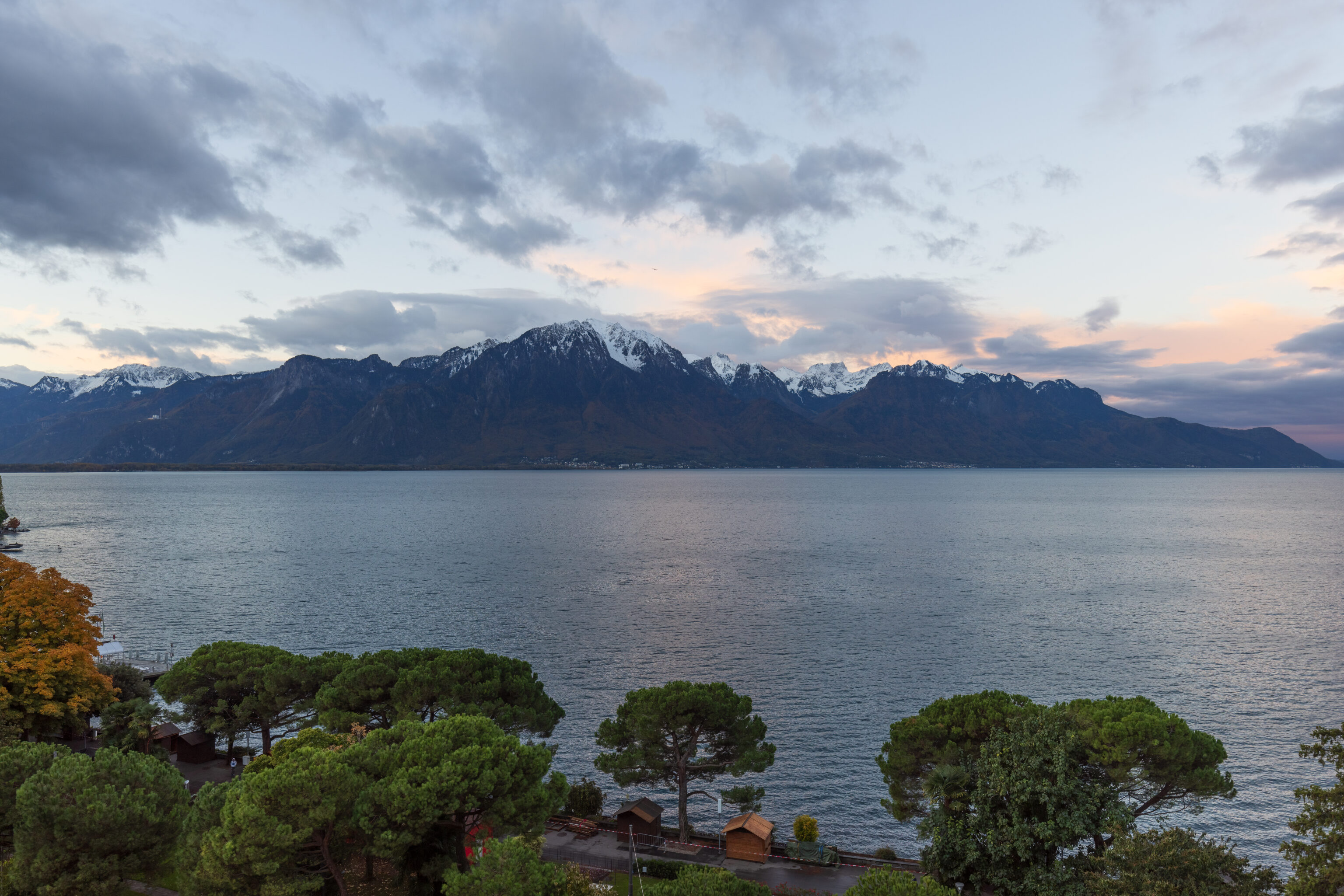
We were pleased to see a partly clear sky in the morning and the absence of rain!
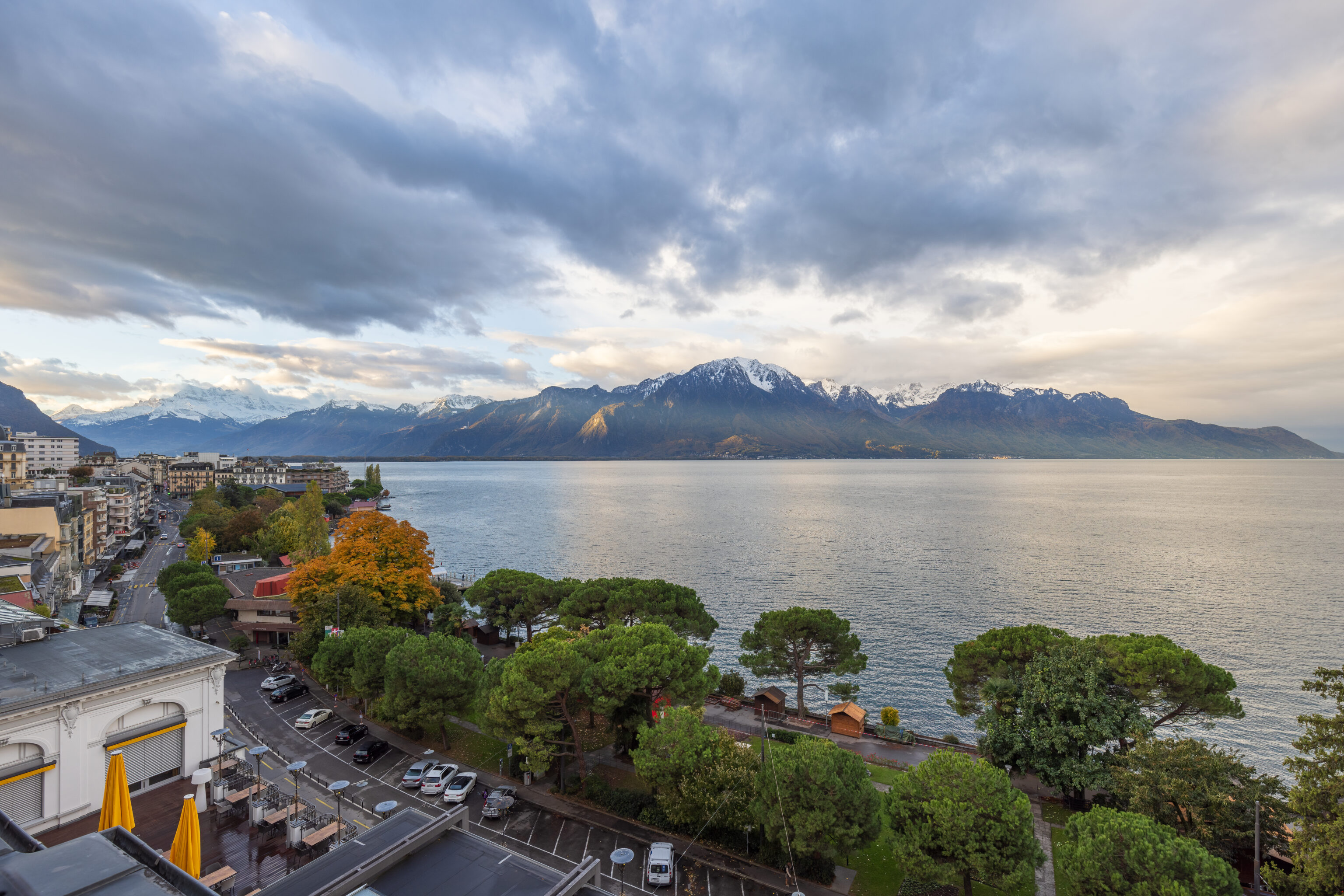
The scene was a bit brighter though still cloudy when we headed to the train station across the street from the Grand Hotel Suisse Majestic.

We caught a Trenitalia train operating as a cross border EuroCity service. This train goes from Geneva to Milan with just a few intermediate stops. Our journey from Montreux to Domodossola was scheduled for roughly 90 minutes with stops at Sion and Brig in between.
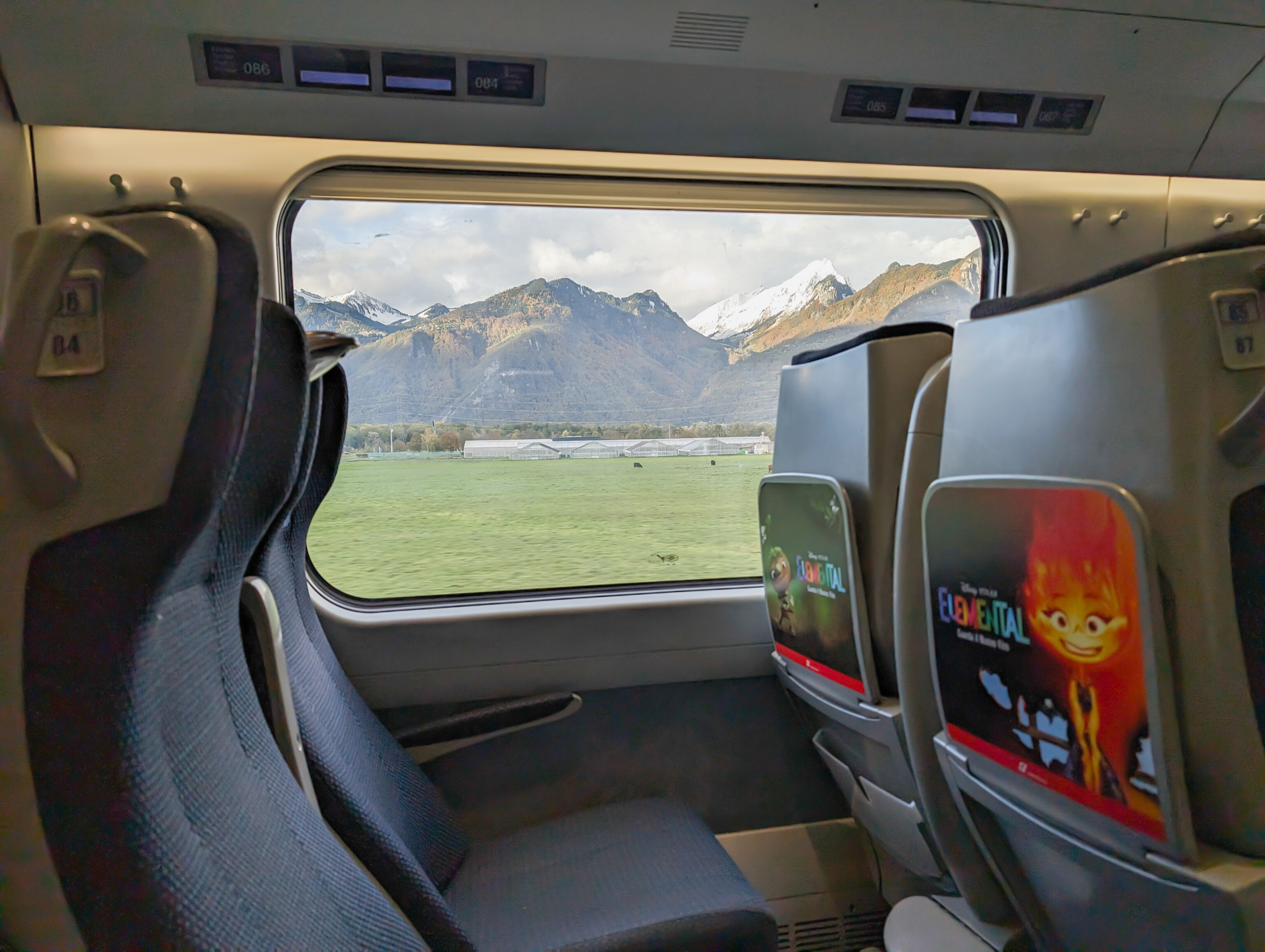
The train wasn’t too full but it was hard to find a pair of unreserved seats. Although you can buy tickets for this train using the Swiss SBB app, it is unable to reserve seats. It seems it probably needs to be done directly with Trenitalia. The seats on this train were very tightly spaced, like flying economy class. It makes the standard second class Shinkansen seats in Japan seem spacious! The Swiss trains have better seating as well.

After arriving at Domodossola, we paid Signore Pipi one Euro each to use the bathrooms before exiting the station. We came across this monument across the street to the Italian Resistance during World War II.
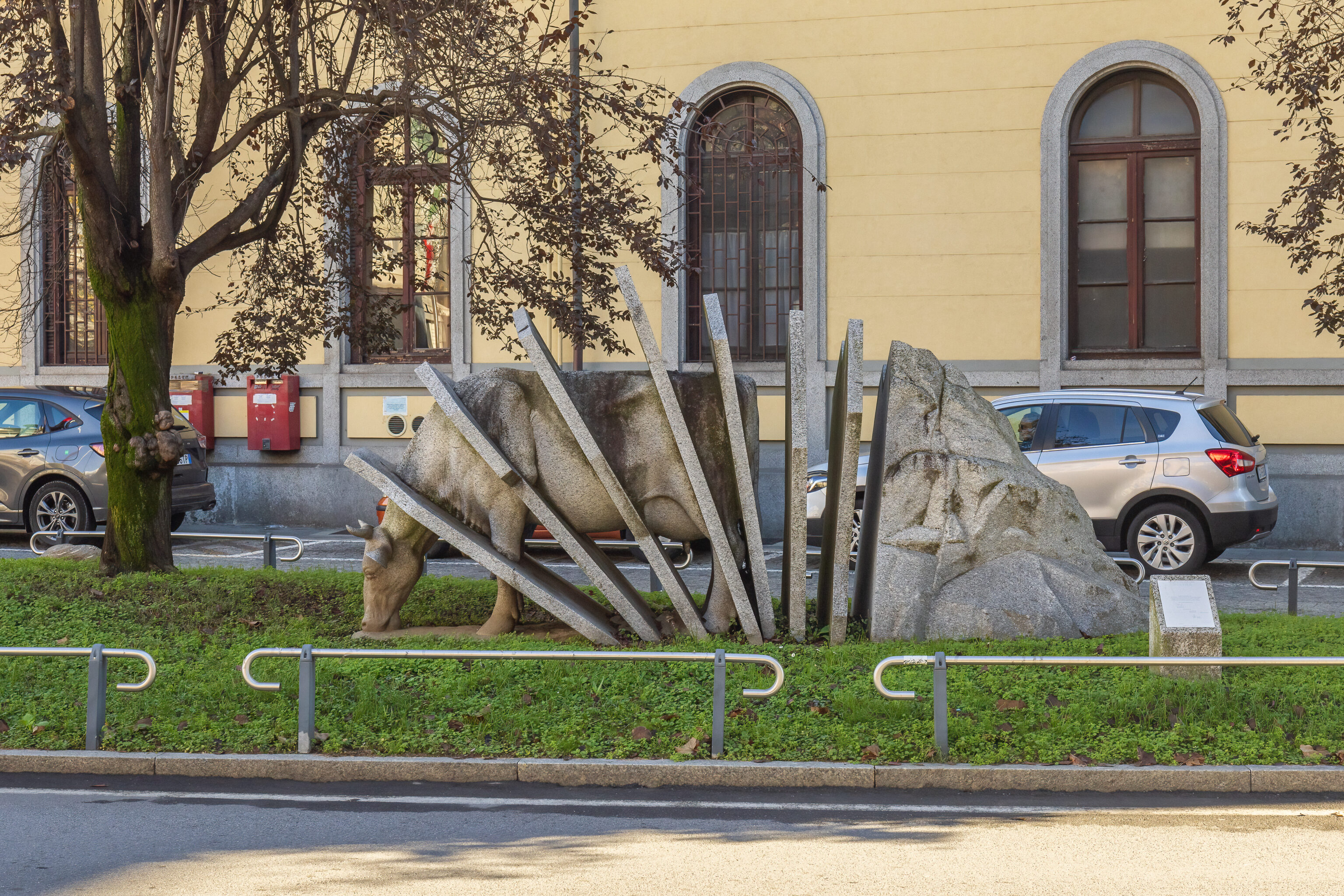

This interesting sculpture of a cow was in front of the train station.

We started walking to the west, heading for the Piazza del Mercato. We passed by this street lined with identical trees showing some beautiful fall colors.


We walked a few short blocks to get there. It was pretty quiet out, not many people were around and businesses weren’t really open yet.

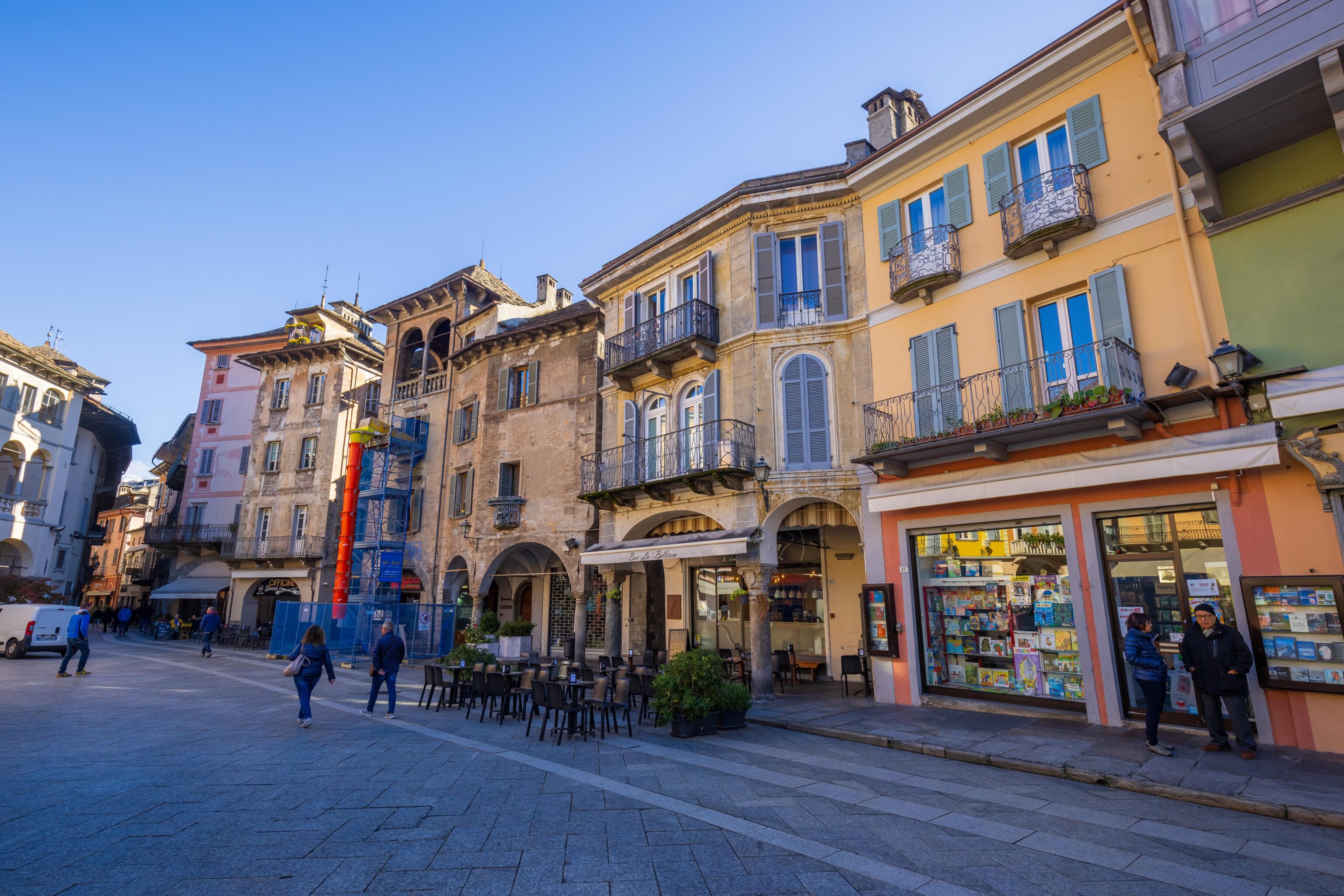
The Piazza was pretty quiet as well, though there were a few more people out and about.

After taking a quick look around, we started to walk to the west. We passed by this building with a nicely painted exterior. It seems like it may just be someone’s house?

We passed by another World War II memorial. Domodossola was the site of a briefly successful uprising during the war1. It didn’t last long and was quickly crushed by the German and Italian armies.

This building caught our attention because of six potted plants on the roof. They look a bit like palms but also resemble pineapple plants. The building houses the Collegio Mellerio Rosmini which seems to be a restaurant management school.
There were at least two primary schools nearby. We saw and heard many children!

We walked by this church, the Santuario della Madonna della Neve.

One of the schools was on the other side of this tree lined fence.

Soon, we could see a literal sign of our destination, the Sacro Monte Calvario! A bit of this UNESCO World Heritage site can be seen on the left at the top of the hill. This religious site has an elaborate Via Crucis (Way of the Cross). There are 15 stations, most of which are in their own small building. Wikipedia provides a listing of the stations2:
- Jesus is condemned to death
- Jesus takes up his Cross
- Jesus falls the first time
- Jesus meets his Mother
- Simon of Cyrene helps Jesus carry the Cross
- Veronica wipes the face of Jesus
- Jesus falls for the second time
- Jesus meets the women of Jerusalem
- Jesus falls for the third time
- Jesus is stripped of his garments (sometimes called the “Division of Robes”)
- Jesus is nailed to the Cross
- Jesus dies on the Cross
- Jesus is taken down from the Cross
- Jesus is laid in the tomb
The 15th station, Resurrection of Jesus, is listed as an extra.

We passed over a small mostly hidden stream. There was quite a bit of greenery around it as well as some small scale farming.
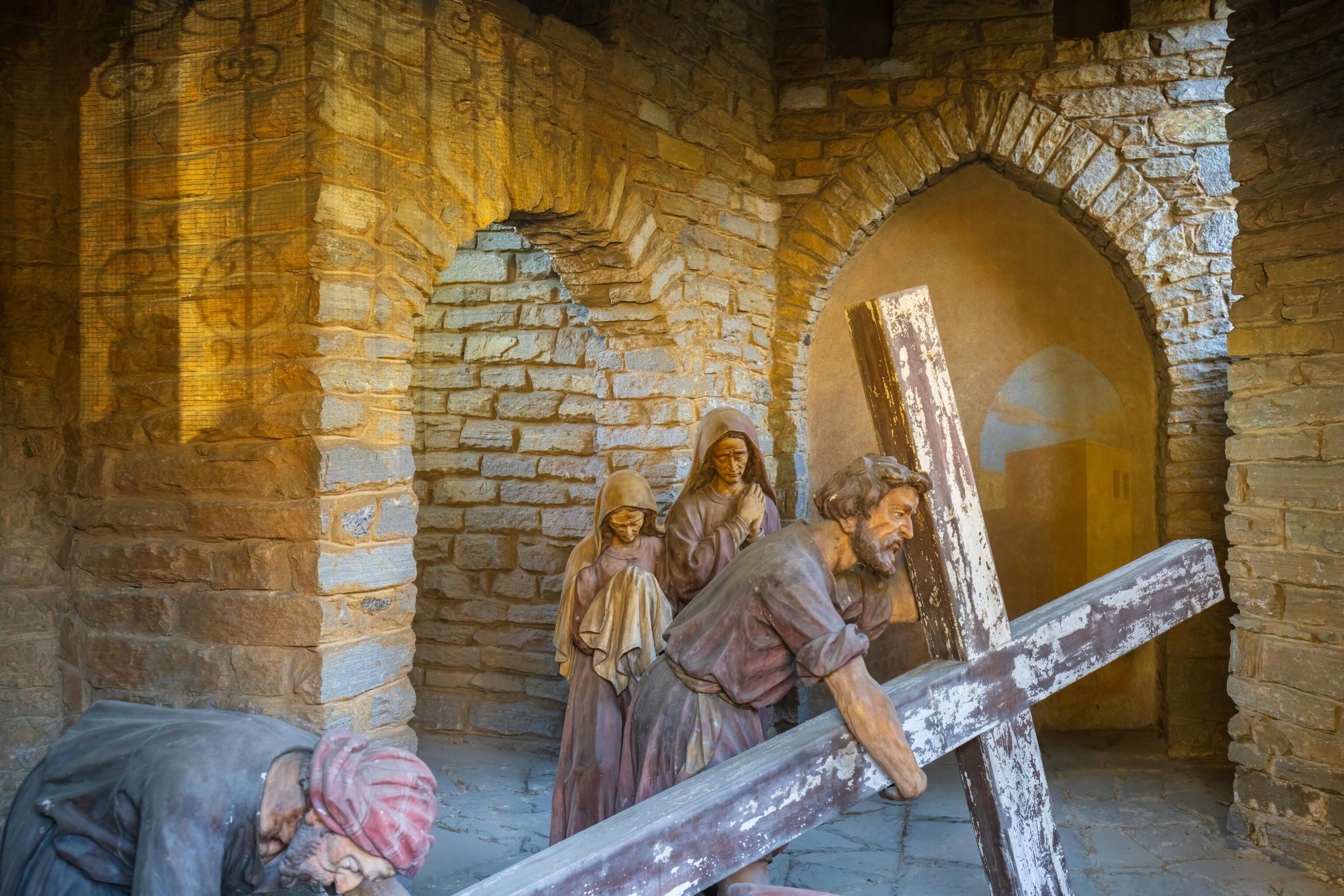
The first station that we came cross was #3, Jesus falls for the first time. A sign provides some information about this depiction:
Last of the chapels, constructed for the 250th anniversary of the foundation of Sacro Monte Calvario, was designed by Engineer Stefano Molli from Turin. An inscription carved on the façade reminds the visitors that the foundation stone was laid on 19 June 1907 by the bishop of Novara Monsignor Giuseppe Gamba, whose coat of arms is engraved above the door. The chapel has a regular plant, with six windows, a cymatium supported by modilion and a small pronaos sustained by two granite columns. The six wooden statues, laid in 1947, are the work of the pavonian sculptor Belluta from the Artigianelli workshop of Milan. The scenario, part masonry and part painted, was designed by the Rosminian Prof. Giorgio Savaglio.
We weren’t sure where stations #1 and #2 were as we didn’t have a map, though we could have found one on the internet.

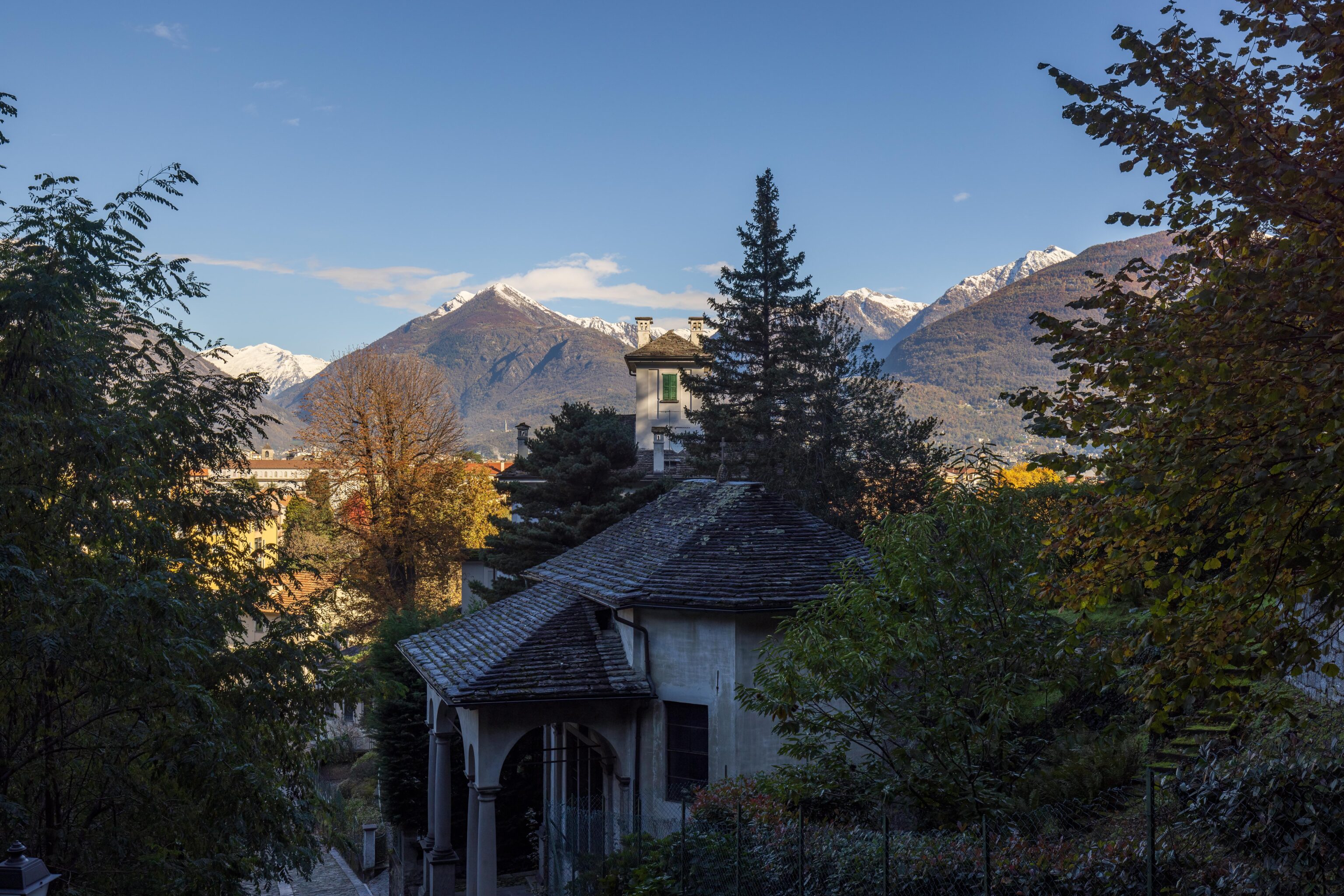
The paved path climbed steeply and steadily upwards. The area was forested but we could see the mountains in the distance.

We next came across #5. Wikipedia’s title, Simon of Cyrene helps Jesus carry the Cross, is more understandable than the sign which simply says, The Cyrenaic. Perhaps it is more understandable to Catholics? The rest of the sign states:
The classic shape of this chapel is rather unusual; the circular base, covered by a hemispherical dome preceded by a pronaos with four Doric columns made of granite of Baveno, which support a tympanum. The chapel, designed by architect Gian Luca della Somaglia dates back to 1835-1837 while the inspired internal decoration by painter Luigi Hartman goes back to 1848. The group of wooden statues, carved by the firm Vincenzo Demetz of Ortisei in Val Gardena, was installed in 1957 for the third centennial anniversary of the foundation of Sacred Mount Calvario.
So, where was #4? It was probably in that building in the middle of the hill that we simply walked by. Oops. We were probably quite focused on going up the very steep path!
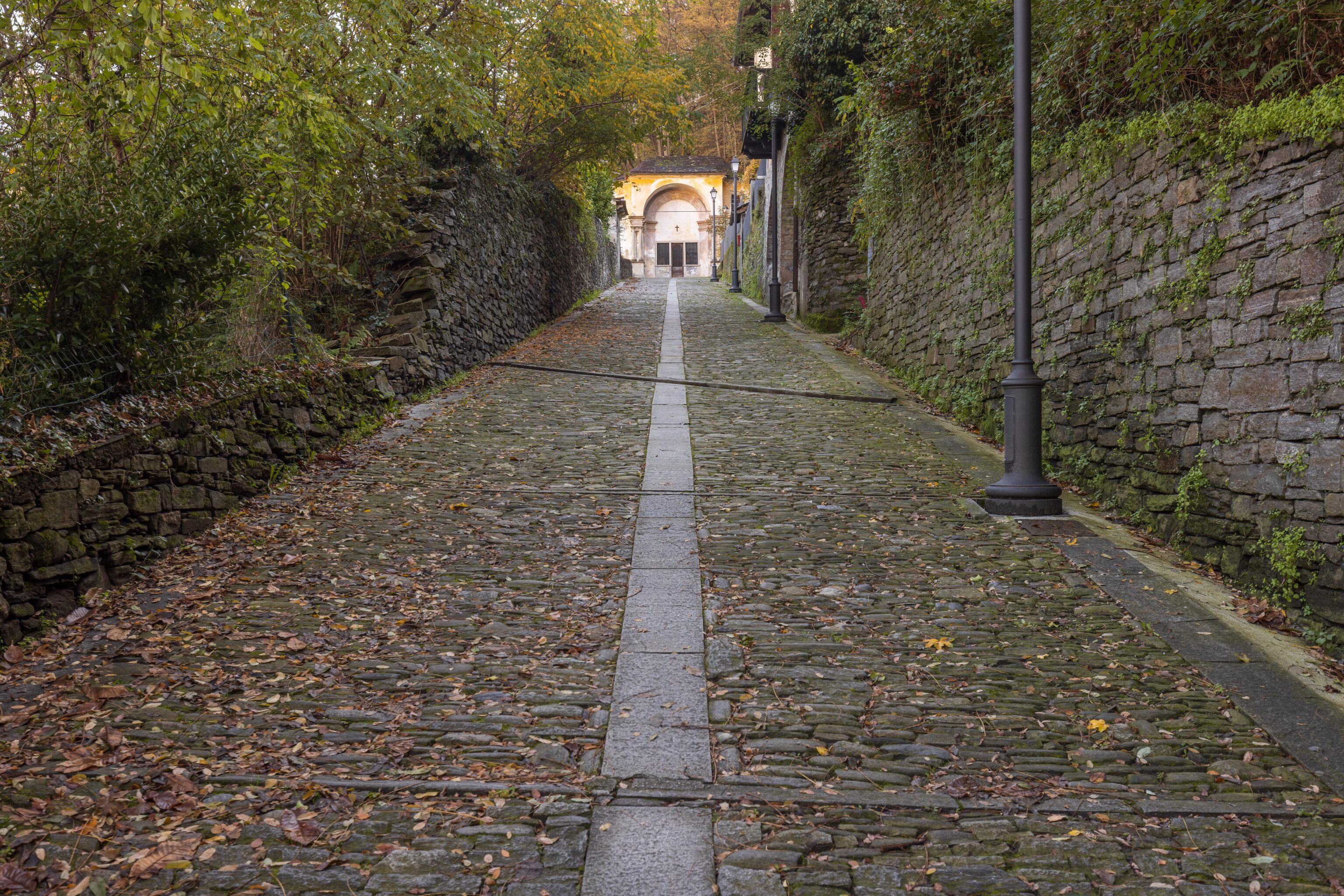
The path continued to climb steeply. Is that station #6 at the top?

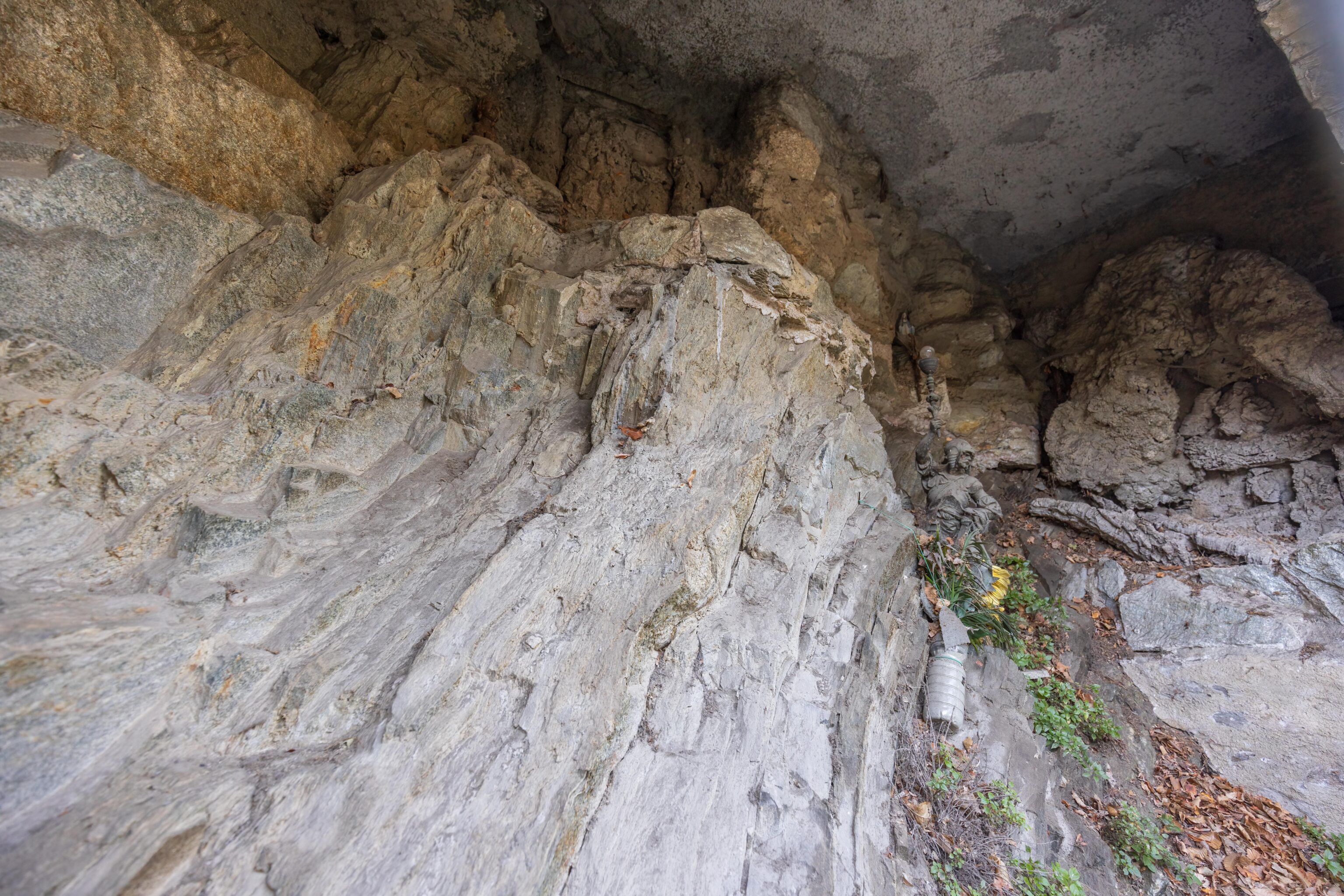
We passed by this seemingly informal display at the base of a building on the right.

Station #6 was indeed at the end of the path. Once again, there was a useful sign with English:
The construction of this chapel dates back to 1772, but for a long time it was left unfinished. Its mixtilinear design is characterized by a frontal arcade, where two twin columns of local stone support a great arch. It was only in 1854 that the painter Paolo Ranieri of Cannobio frescoed the background depicting the Mistery of Jesus meeting the Veronica. In 1957 the work by Raineri was effaced and replaced with a scenario, part masonry and part painting, to represent a road of Jerusalem and the nine wooden statues that compose the group, carved by the firm Vincenzo Demetz of. Ortisei in Val Gardena, were put in place.
This particular station was protected by what can be described as a metal grate window with bars in a square pattern. The bars were relatively thick and the squares were relatively small. Larger mirrorless or DSLR cameras have trouble with these types of windows as the open squares are too small and the metal bars are too thick to blur away.

My cell phone camera was able to capture a wider shot due to the metal grate window. But the scene was very dark and the image is very overprocessed, giving the whole scene a bit of an unrealistic appearance. Though, it requires looking closely at the photograph.

We continued on. The path turns and continues to climb. From here, we could see the mountains in the distance as well as the buildings of Domodossola.
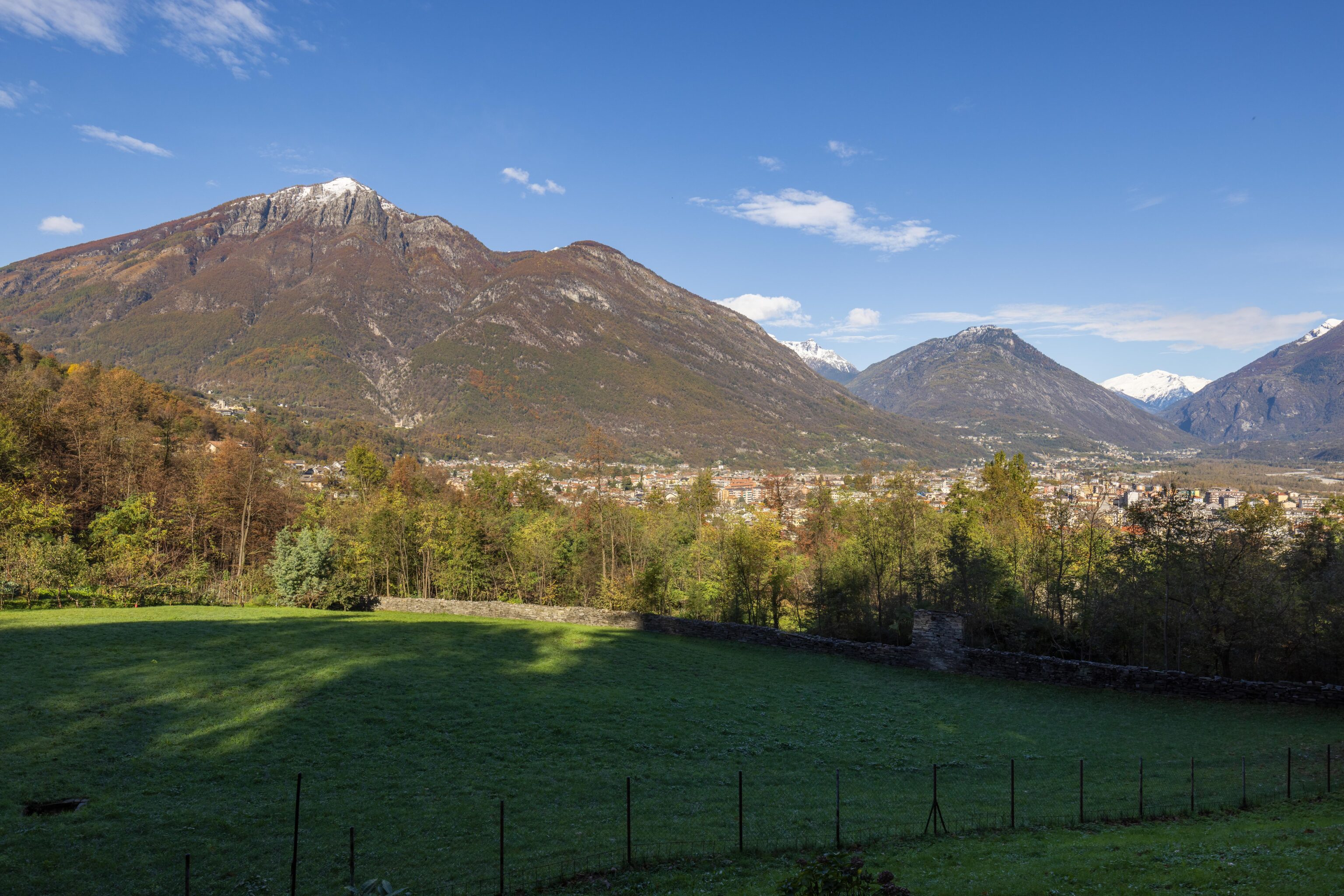
The path continued to climb as we passed by this large grassy field. Right before reaching the field, there was a sign:
THE ROLE PLAYED BY THE CAPPUCCINIS AND THEIR SACRO MONTE MONASTERY The disciples of St. Francis, the Friars Minor, played a vital role in promoting the construction of the Sacri Monti and spreading the devotion of the Via Crucis. The Sacri Monti of Varallo, Varese, Orta and Domodossola were all the result of Franciscan initiatives. In fact, the construction of the Sacro Monte Calvario is attributed to two Cappuccin friars, the fathers Gioachino da Cassano and Andrea da Rho, who submitted the project during lent 1656. This is reported in a memoir by jurisconsult Giovanni Matteo Capis, who was assigned the work by the bishop of Novara, Mons. Giulio Maria Odescalchi. So the idea came from the two Cappuccin friars, but was picked up and completed by the entire Ossola Community which supported the project through monetary contributions or working days. The Sacro Monte project included also the construction of a monastery for the Cappuccins, and the hill seemed to be the perfect place, both for its ancient sacredness and the position protected from floods. Today the remains of the monastery can be seen along the uphill track leading to the Calvario. The construction of the building was started in 1667 based on architect Tommaso Lazzaro's design. In 1810, under French rule, the Cappuccin Friars were turned away from their monastery following the suppression of the religious orders as dictated by the laws of the Cisalpina Republic, of which the Ossola was a part. Their monastery was then confiscated and acquired by the State. It took until 1828 for another religious presence to be established on the Sacro Monte with the arrival of Antonio Rosmini. During that period the building was used for barracks and the nearby chapel became a gunpowder depot, so much that in 1830 it accidentally caught fire and blew up. In 1873 the Alpine troops set up quarters in the barracks and in 1926 the building was named after the Domese General Giovanni Chiossi, who had his villa at the foot of Monte Calvario. During the post-war period, the building was used as a shelter for refugees and homeless people, and thereafter was permanently abandoned.
It wasn’t clear to us exactly what buildings this sign was referring to. It was possibly in or around this field.

Soon, we were in front of the next station.

This was station #7. We didn’t see a sign, or perhaps just didn’t notice it?

The view looking down from station #7. Shortly after, we approached the actual sanctuary area. We passed through an entrance and found English language brochures were available:




We headed to the next stop, station #8.
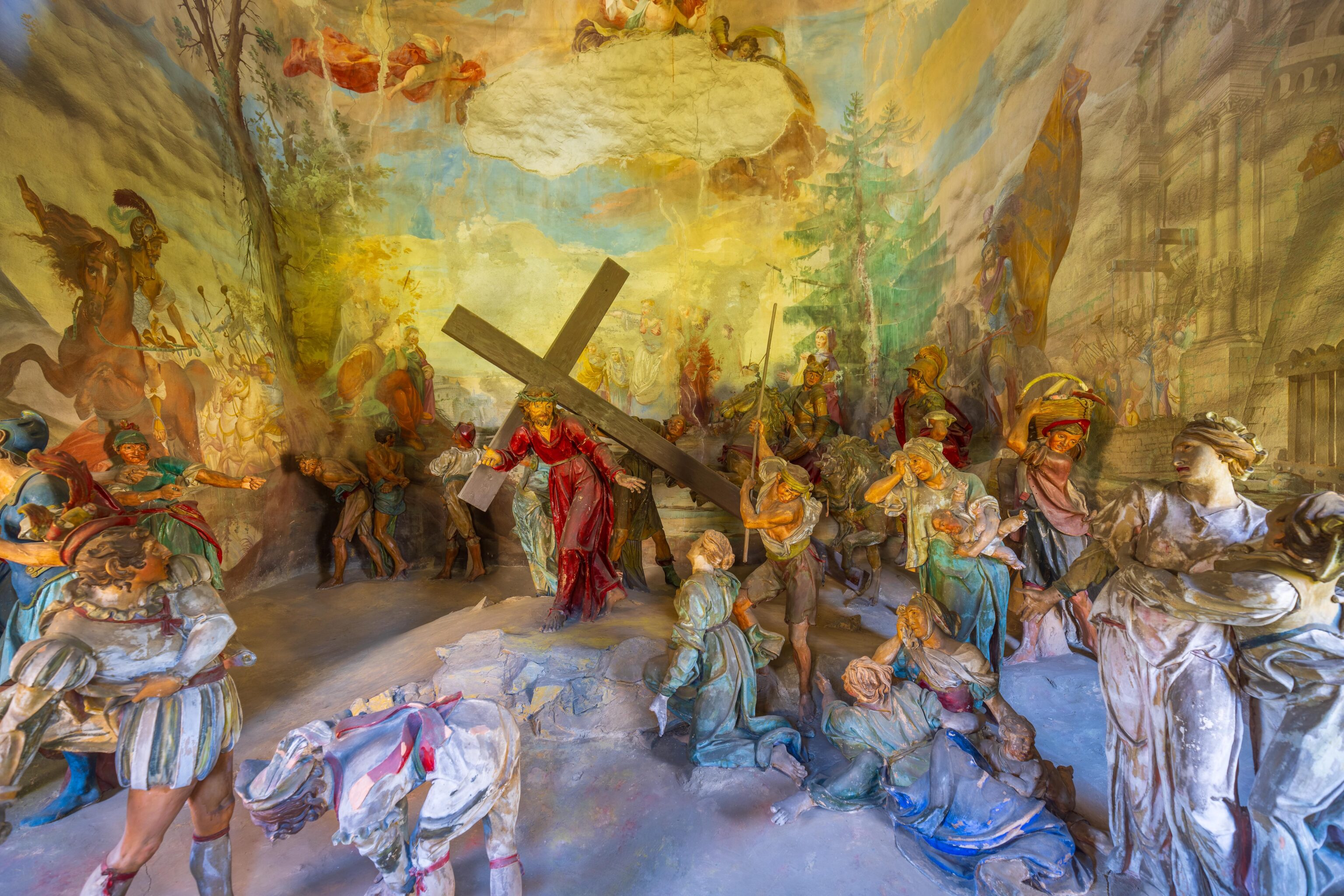
We found a sign here:
CHAPEL VIII Jesus meets the women of Jerusalem Started in 1773, this chapel, designed and realized by architect Pier Maria Perini of Val d'Intelvi, presents an almost square base with a mixtilinear façade embellished by a false portico supported by pillars and columns of local stone. 25 statues modelled in local clay by Stefano Salterio of Laglio (Como) were installed in this chapel in 1782. The brothers Giuseppe and Giovanni Antonio Torricelli from Lugano painted the entire complex and imaginative background scenario between 1779 and 1780. The Mystery of Jesus meeting the women of Jerusalem is depicted in a rather expressionistic fashion, a style favoured by the popular taste of the time.
The next station, #9, was nearby.

Unfortunately, it was being renovated so we could not get any closer. There was a sign but it was too far to read.

There are numerous buildings in this sanctuary area.
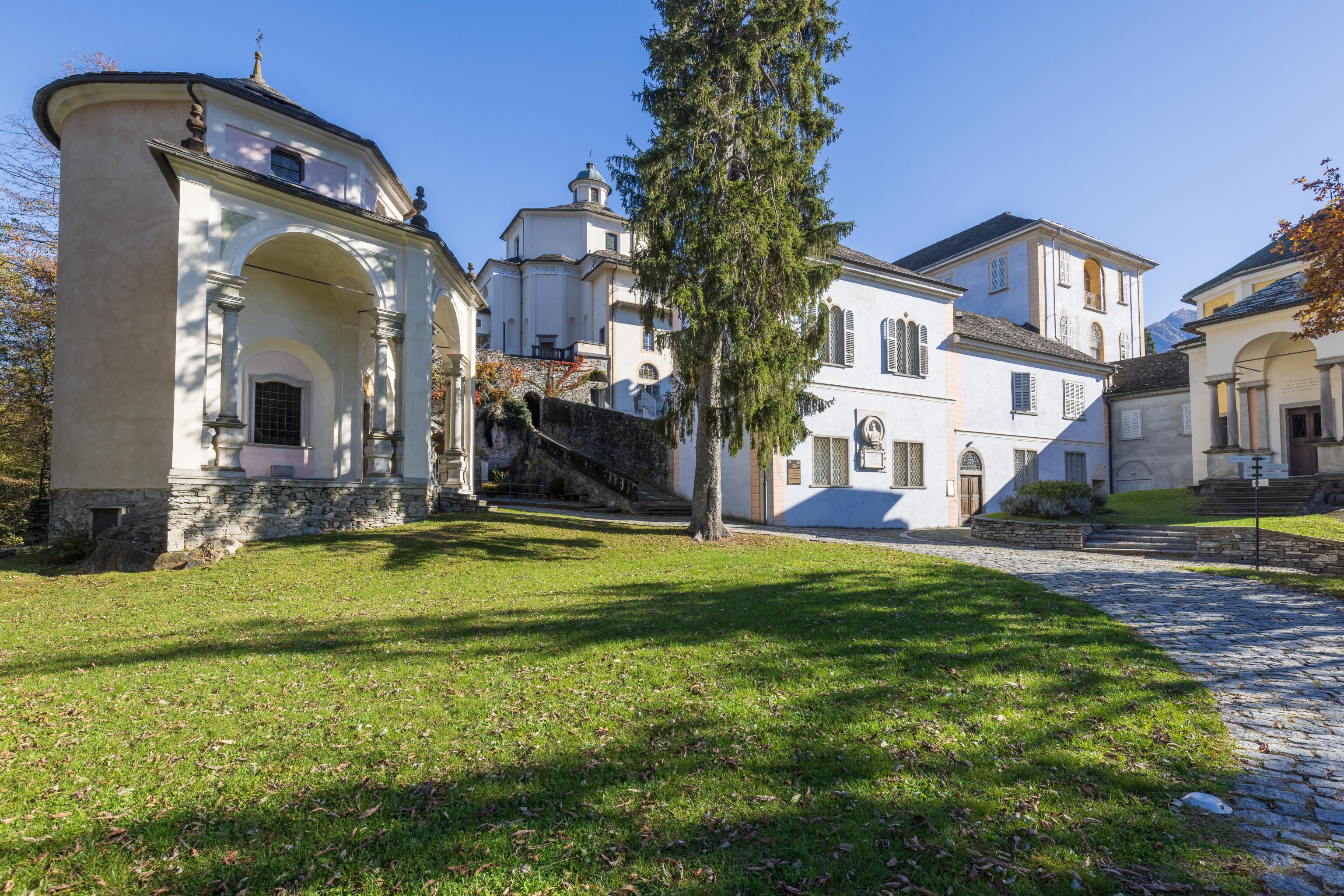
We walked towards the cluster of buildings ahead of us.
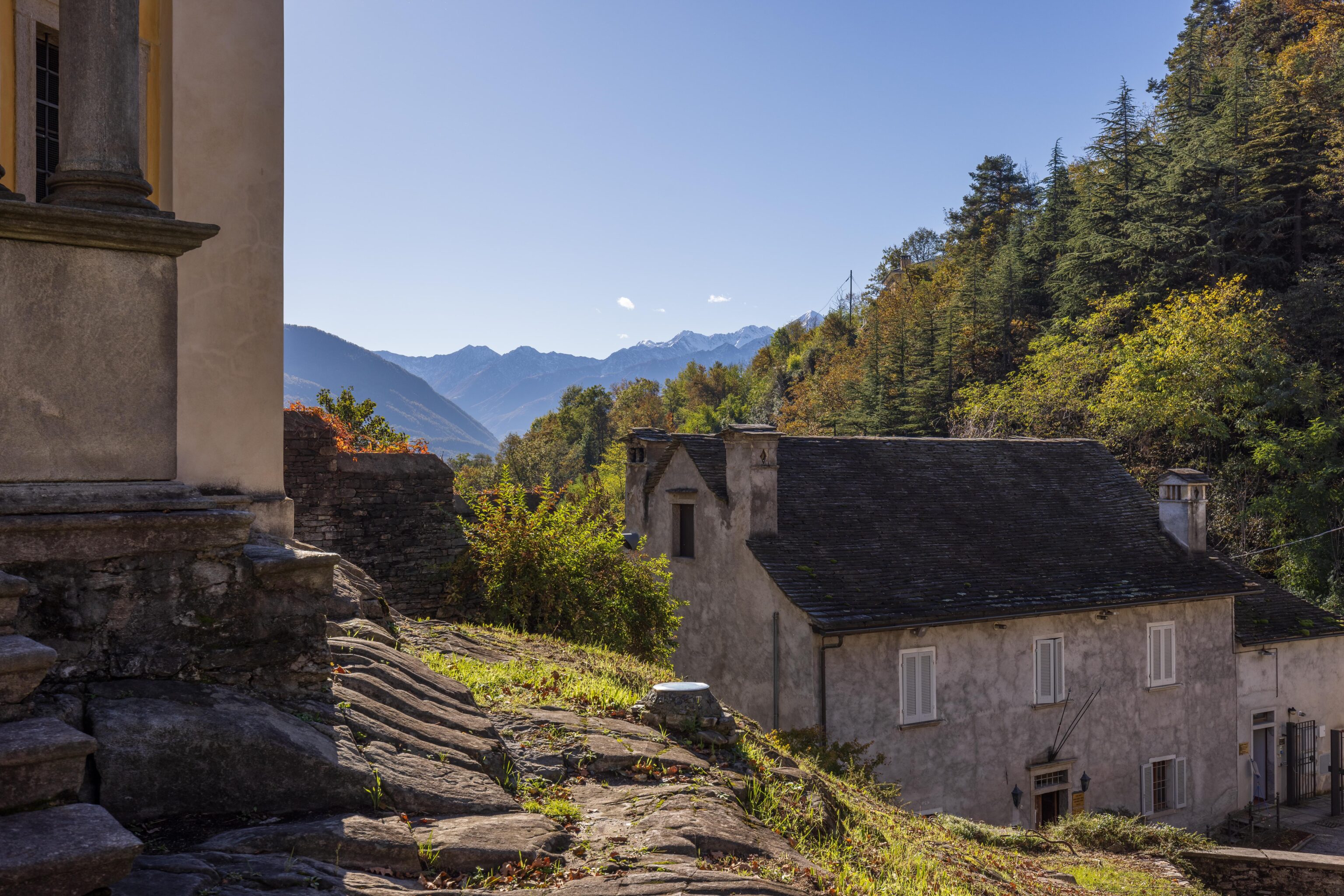
The view from in front of the next station.
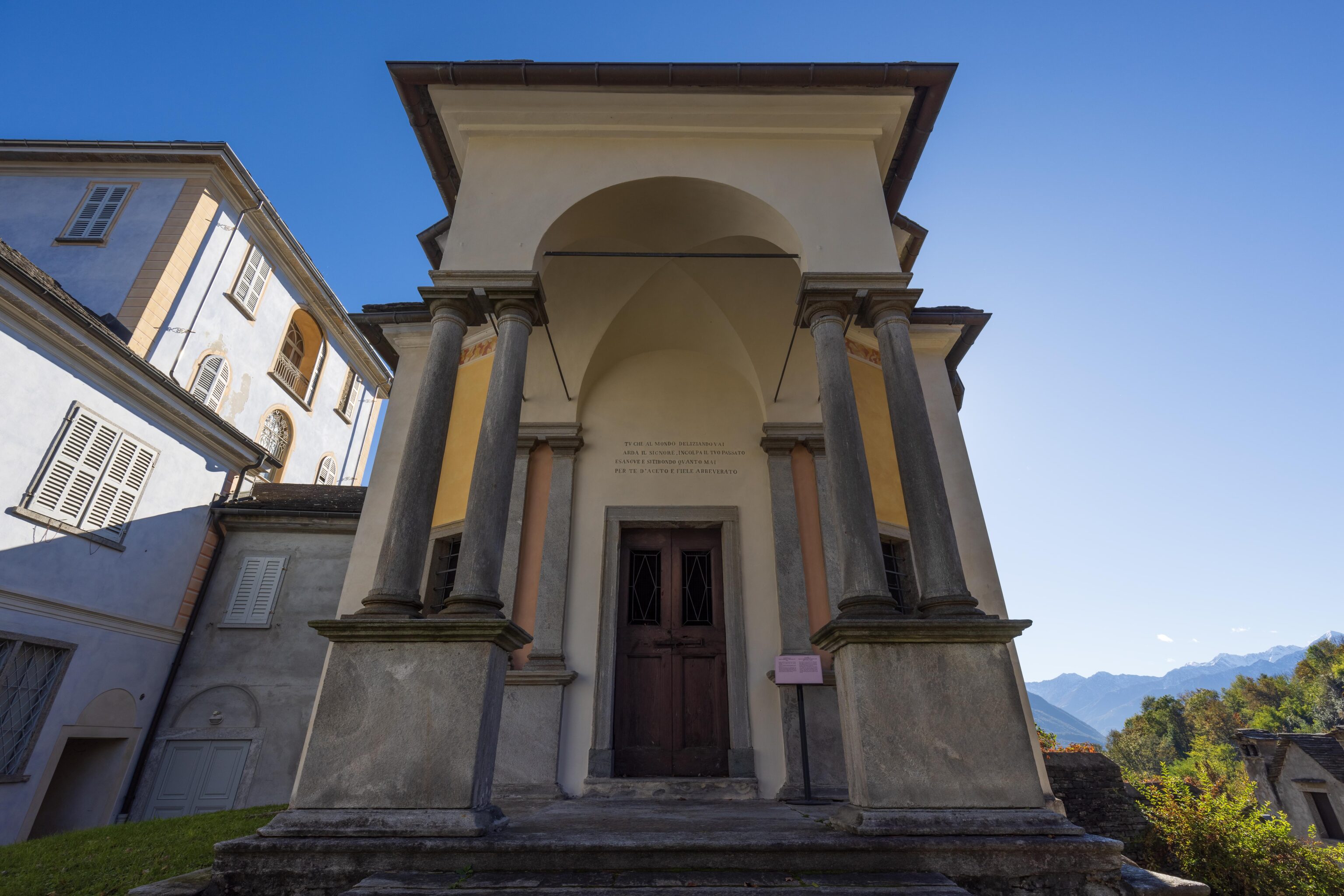
It was attached to the other buildings.

Station #10 had a sign:
CHAPEL X Jesus is stripped of his Clothes and given Gall to drink The construction of this chapel was started in the early 1700 and completed in various subsequent phases. It has a mixtilinear base and is crowned by a small octagonal dome. The entrance is embellished by a series of steps and by a small portico supported by two groups of columns of local stone. Pier Maria Perini of Val d'Intelvi was the architect who designed and supervised the construction. Giuseppe Rusnati of Milan modelled the plasticized group of statues depicting the Mistery of Jesus stripped of His clothes. In 1764 Lorenzo Peracino da Cellio painted the statues by Rusnati and decorated the background with brightly colored frescoes.

There was a carved stone plaque on the side of the adjoining building. It is dedicated to Antonio Rosmini, who completed the construction of this site.

This plaque describes this site’s World Heritage status. The English text at the bottom reads:
In accordance with the Convention for the protection of the world cultural and natural heritage, the Site of the Sacri Monti of Piedmont and Lombardy has been inscribed in the World Heritage List. Its inclusion on the List consecrates the outstanding universal value of a cultural or natural asset in order to guarantee its protection for the benefit of the whole of humanity, The nine Sacri Monti (Sacred Mountains) of this region in northern Italy are groups of chapels and other architectural features built between the late 15th and early 18th centuries and dedicated to different aspects of catholic belief, In addition to their symbolic spiritual meaning, these complexes offer a wonderful example of the integration of architectural elements into the surrounding landscapes of hills, forests and lakes. They also house an extraordinary artistic heritage in the form of statuary and frescoes.

We continued onward around the building.

But first, the next station was in a building kind of diagonally across the path.


The sign for station #11 states:
CHAPEL XI Jesus is crucified 1768, the date engraved on a stone in the basement of this chapel, refers to the start of the works. The construction of this building, characterised by a mixtilinear base and a semihexagonal front portico supported by pillars and columns of local stone, was supervised and completed by architect Pier Maria Perini of Val d'Intelvi. The plasticized group of statues representing the Mystery of the Crucifiction was made in Domodossola and placed in the chapel in 1776 by the Valsesian plastic clay modeller Giovanni Luca Raineri of Rossa. The brothers Giuseppe and Giovanni Antonio Torricelli of Lugano painted the background scenarios of the chapel between 1779 and 1780.

Time to continue! We took a brief look at the little fenced in cave-like area at bottom left. It seemed to be dedicated to donors. There were two possible paths from here. Up the ramp on the right, on via a path to the left that goes around and up. We briefly went to the left but decided to backtrack and take the ramp.

The ramp was angled with stair-like bumps.

The view looking down.

The next station we came across was #14. It was on the side of the sanctuary building and accessed by looking in through a window on the outside after climbing some outdoor stairs. It is kind of like Titanic, you know what is going to happen, so skipping 12 and 13 shouldn’t be much of a spoiler.

This was the view from atop the outdoor stairs. The building near the center is station #11.
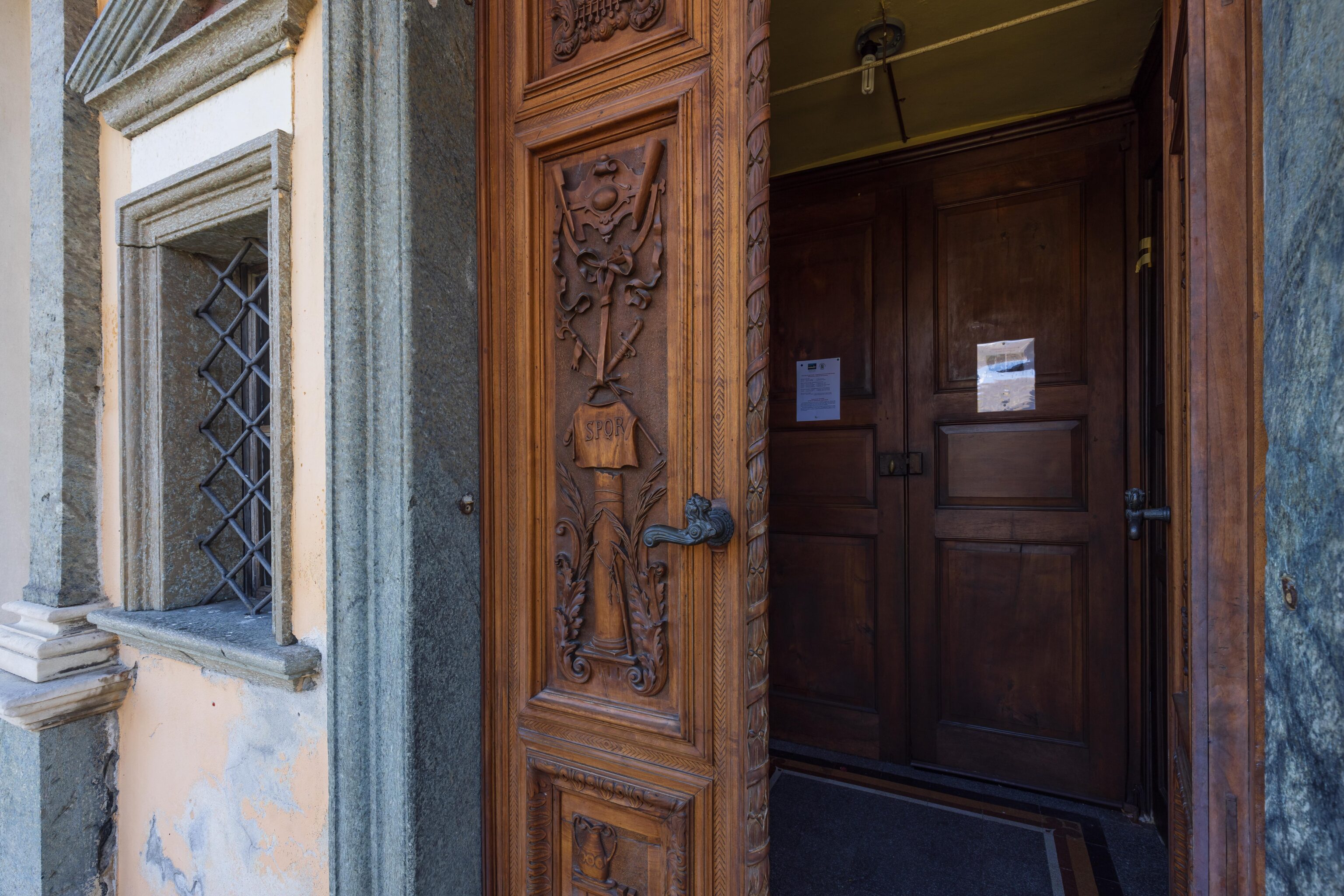
We backtracked down the stairs to enter the sanctuary building. We were at first a bit surprised to see SPQR but remembered that we are in Italy, though this site is well after the ancient Roman period.


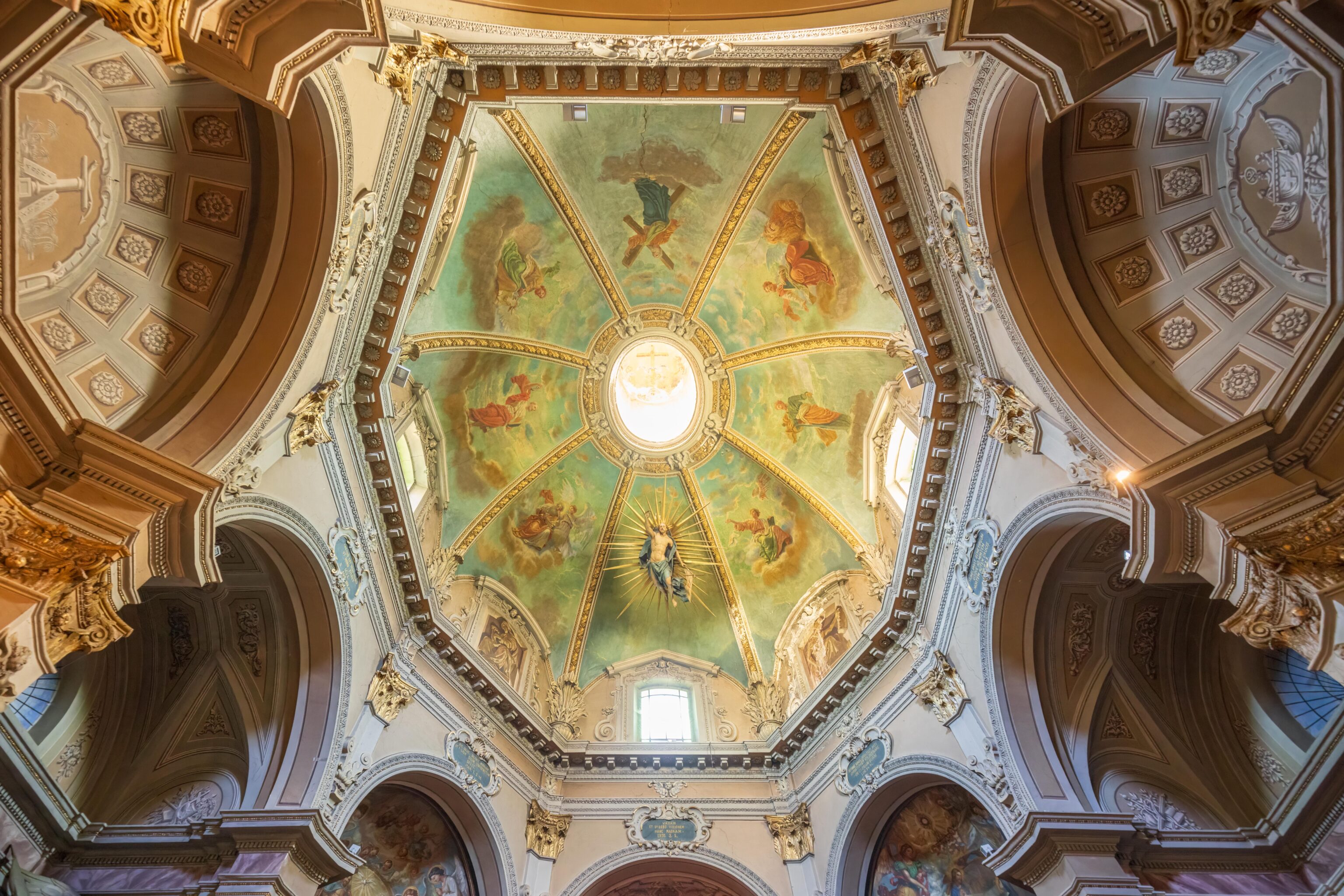
The interior is quite different from how plain this place looks from the outside! Every surface seems to be decorated in some way! Christian imagery is everywhere, from paintings to sculptures.

Directly ahead was station #12. A sign reads:
CHAPEL XII Jesus dies on the Cross Placed in the chapel in 1662, Christ dying on Mount Golgota is the best of the works that the plastic clay modeller Dionisio Bussola left to the Sacred Mount Calvario. This precious statue, larger than normal size, towers from the altar above the surrounding space conveying a strong feeling of tragic, sublime and misterious expectancy. The statues of the Blessed Virgin Mary and Saint John on both sides of the Cross and of the weeping Magdalen at the foot were put in place in 1663. In 1921 Francesco (Cino) Bozzetti painted the background of the window while the group of stucco angels framing is the work of the Valsesian plastic clay modellers Carlo and Giovanni Giovanninetti (Zaninetti).

The interior of the sanctuary is octagonal. This was the next side.
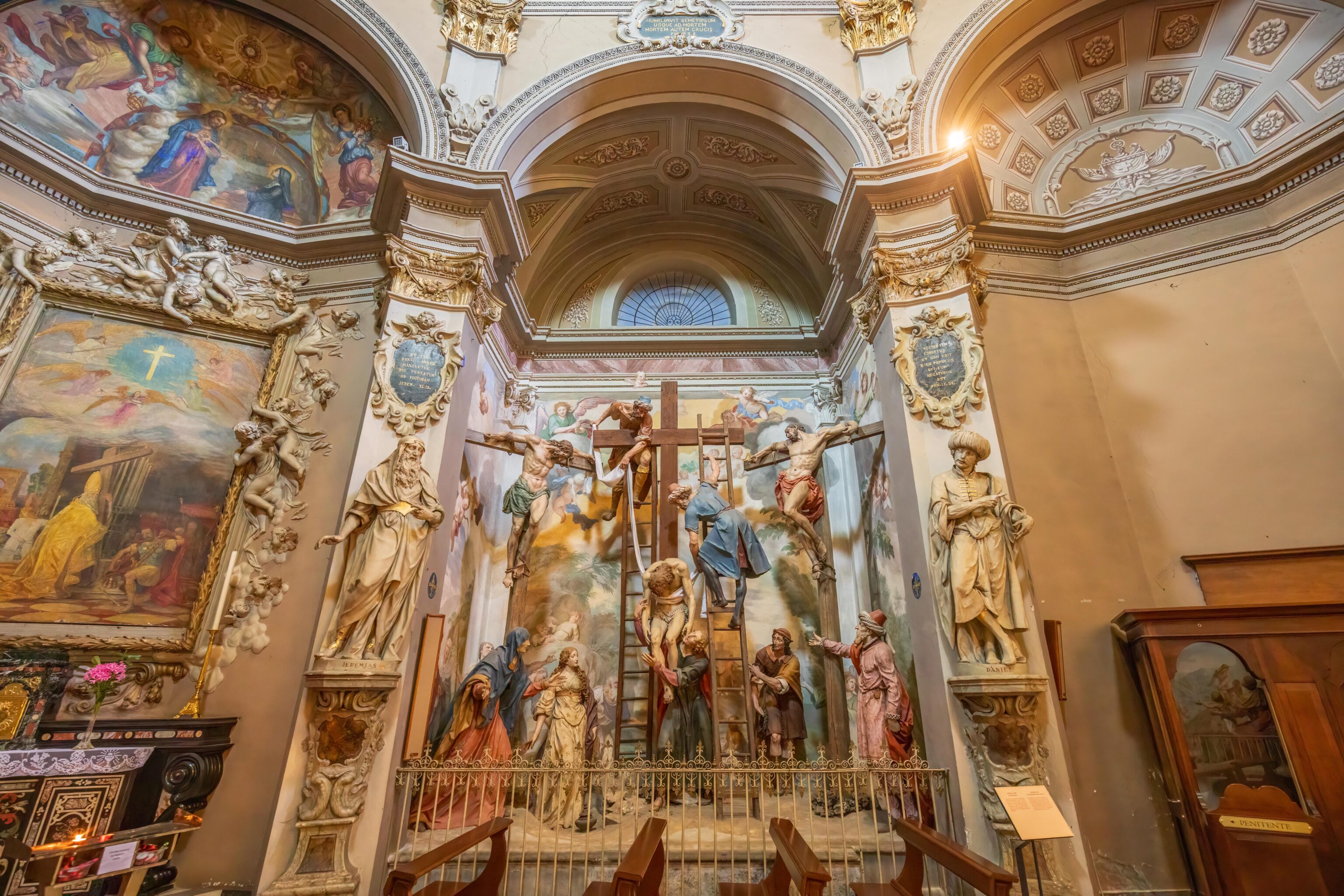
Again to the right, we saw station #13.
CHAPEL XIII The Deposition from the Cross The vigorous terracotta statues representing the Deposition from the Cross are among the most beautiful realized by Dionisio Bussola. The Pietà accompanying the scene of the deposition of Christ is in strong contrast with the violent exhibition of the bodies of the good and the bad thieves stretched on the cross. The plastic clay group was placed in the chapel in 1664; the frescoes in the background by Giovanni di Sampietro date back to 1699.
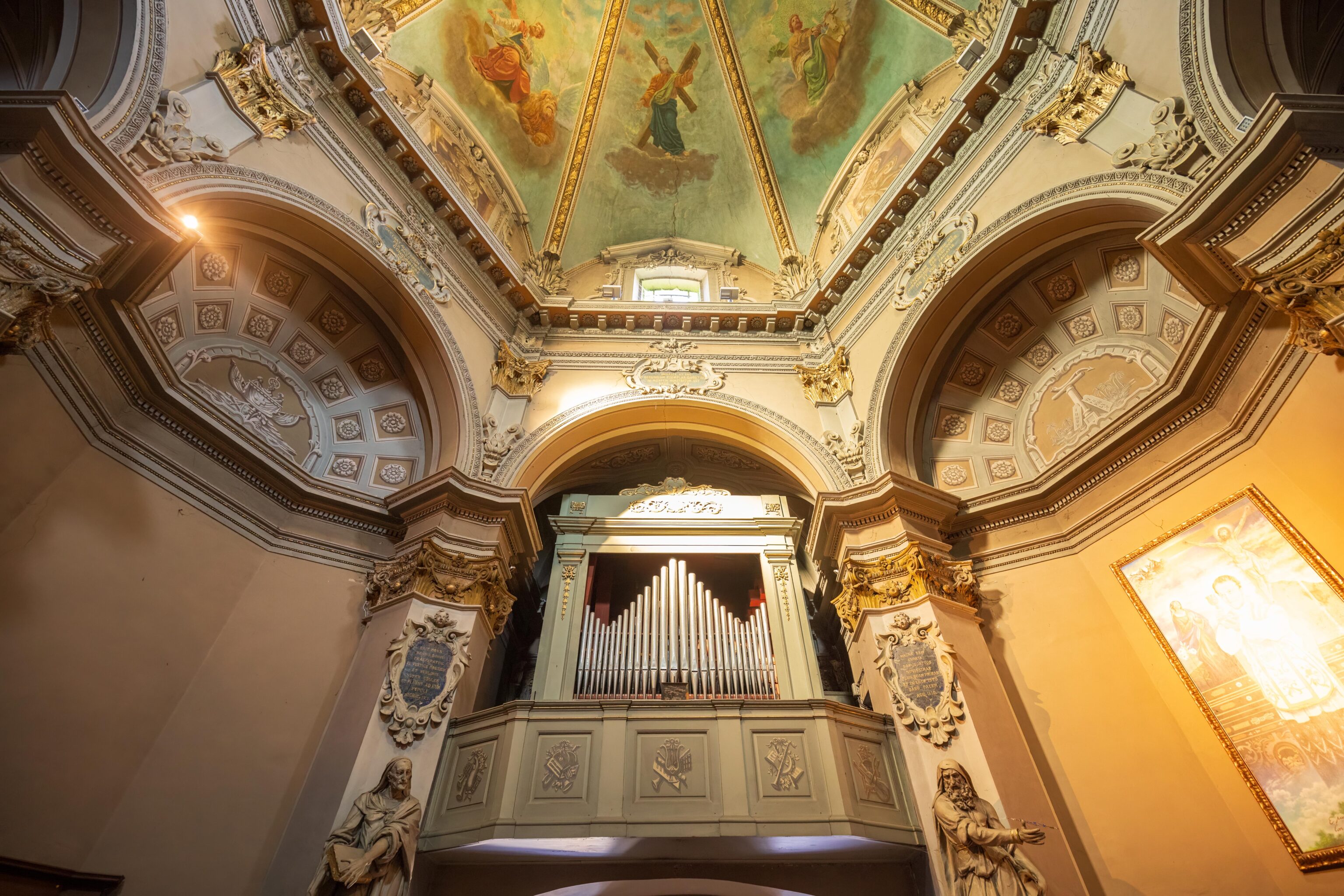
Skipping one side to the right, this organ was above the entrance.

This next side had votive candles.

The next side contained the Chapel of the Vision of the Cross. A sign explains:
Initially this chapel was to represent the Mistery of the Nativity and of the Adoration by the Three Kings; for better coherence with the theological aspect connected with the Sanctuary it was later transformed as it appears today. The cross held by two angels looking out from up among the clouds appears to the Little Jesus and to the Blessed Virgin Mary as an anticipation of Christ's redeeming mission with an amazed Saint Joseph looking on. In the early 700 the statues of King Jasper and his page, which portrayed Baron Stockalper, were removed and added by Rusnati to the ones included in the chapel of the Resurrection.

The final side, to the left of station #12.

The view looking straight up at the ceiling.

Outside, we passed by a statue of Antonio Rosmini. There was a sign nearby that provided a bit of history:
THE SANCTUARY OF THE HOLY CROSS AND THE ROSMINIAN "CONVENTO" The Sanctuary of the Holy Cross is the heart of the Sacro Monte Calvario and houses the 12 and 13" Stations of the Cross. The Sanctaury was designed by Master Tommaso Lazzaro of Val D'Intelvi, an architect and craftsman well known all through the entire Ossola region. The foundation stone was laid on 8 July 1657 and for the gratuitous work done in favour of the construction, the Bishop of Novara granted the right to work on non-working days except solemn feasts. He also granted a special indulgence of 40 days to the willing workers. In 1659 the construction reached the eaves, and on September 5 of the same year the Vicar General granted permission to celebrate the Holy Mass on festivities in the Presbitery Chapel. The dome covering the central structure of the Sanctuary was erected by Master Tommaso Lazzaro in 1672, while the vestibule was completed only in 1686. The Sanctuary is surrounded today by the Rosminian "Convento", tangible testimonial of the presence of the priest from Rovereto, Antonio Rosmini (1797-1855). One of the major Italian philosophers of the 19" century, Rosmini had an important role in the rebirth of the Sacro Monte Calvario after many years of negligence and degradation caused by the neglect, which followed the suppression of religious orders and expropriation of ecclesiastical properties by the. French Republican governments. Encouraged by Count Giovanni Mellerio, an important politician with strong ties to the town of Domodossola, his birthplace, Antonio Rosmini selected the Calvario to found his Istituto della Carità (20 February 1828), whose members were later named Padri Rosminiani (Rosminian Fathers). Their presence started off a material and spiritual renovation centred around the Sanctuary, with the resumption of the processions from the parishes to the Sacro Monte and of the practice of the Spiritual Exercises. In 1863, the Rosminians acquired the whole complex of Calvario and extended the buildings and the 17 century house (wich was used for making the Spiritual Exercises). This was the birth of the Motherhouse of the Institute, home of the Noviciate which it remains to this day. In 1985, the desire to share more widely the enormous spiritual legacy of Rosmini culminated in the birth of the Rosminian Center of Spirituality. The beatification of Antonio Rosmini on 18 November 2007 has given a new impulse to the spiritual and cultural initiatives at Calvario, and has made it a focus of excellence for pilgrims and visitors.
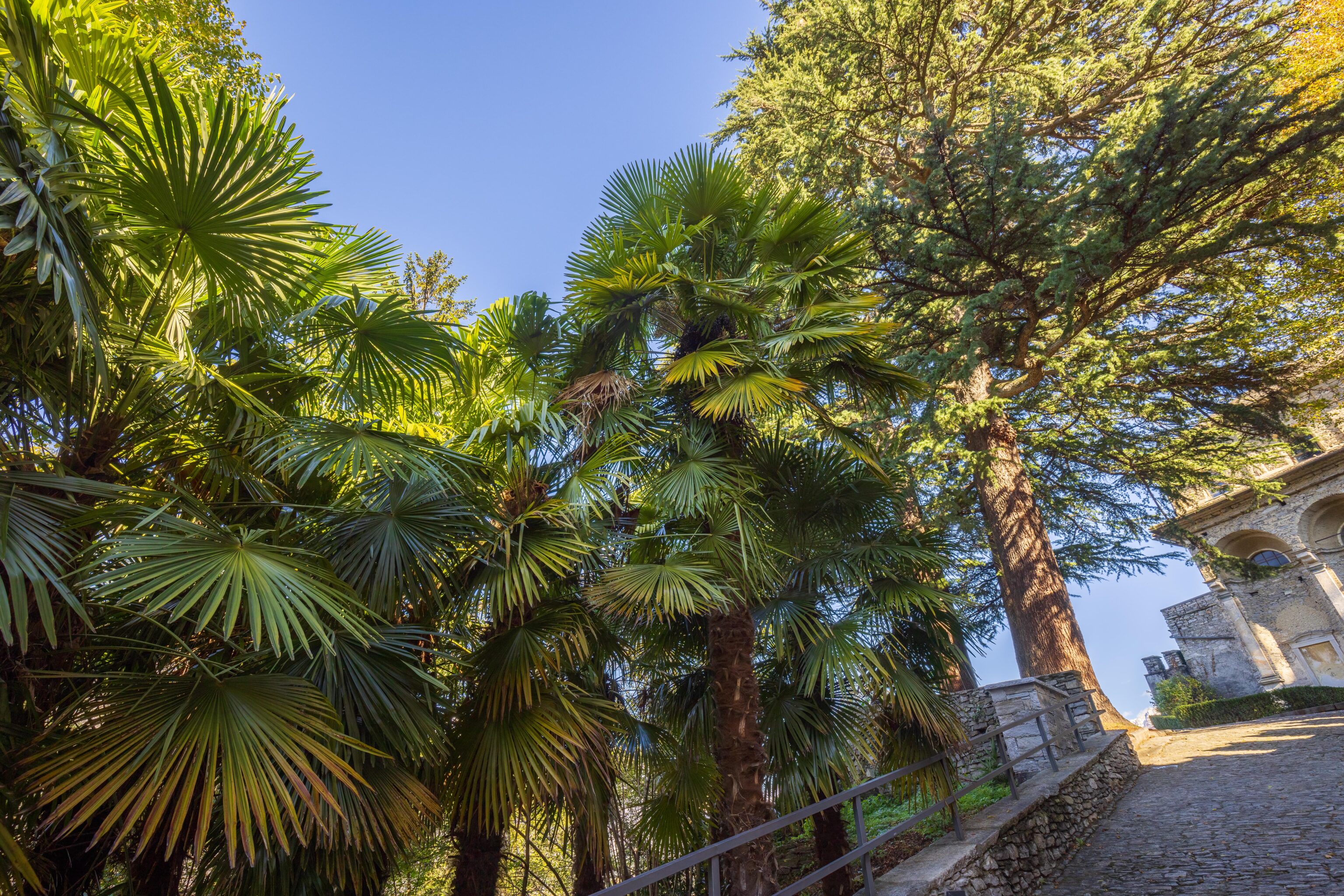
As we continued to walk, we came across palm trees! And, up ahead, we reached the final station, #15.
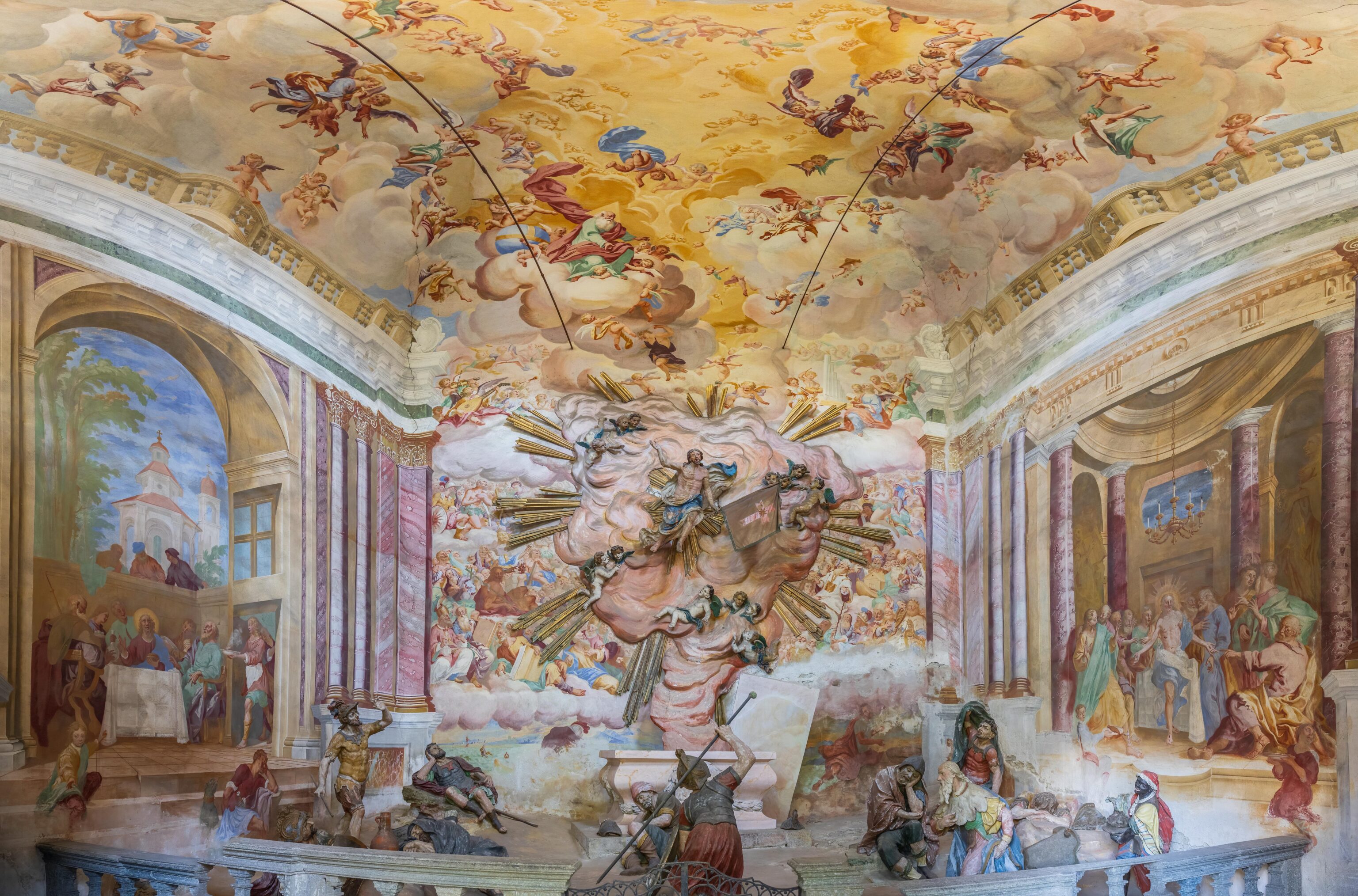
This one is huge and very elaborate. The above photograph is a stitched together panoramic scene which is distorting the straight lines of the painted background. A sign reads:
CHAPEL XV The Resurrection The Via Crucis, as later established by Pope Clemente XII on April 3d 1731, did not include a chapel depicting the Resurrection, but it became evident that the great drama of the Passion and death could not end with the Sepulchre. The excavation of the foundations started in 1690 revealed the remains of a very ancient, biapsidal, Paleochristian church, believed to be the church of the Holy Vergin Mary in the castle of Mattarella. The chapel with a square base was designed by the brothers Perini. The majestic scene of the Resurrection is represented by a group of terracotta statues by Giuseppe Rusnati and by a great background part relief and part painted by Giovanni Sampietro in 1704.



Left, middle, and right sides of the station. These are rectilinear photographs, straight lines are straight.

And the view looking up a bit.
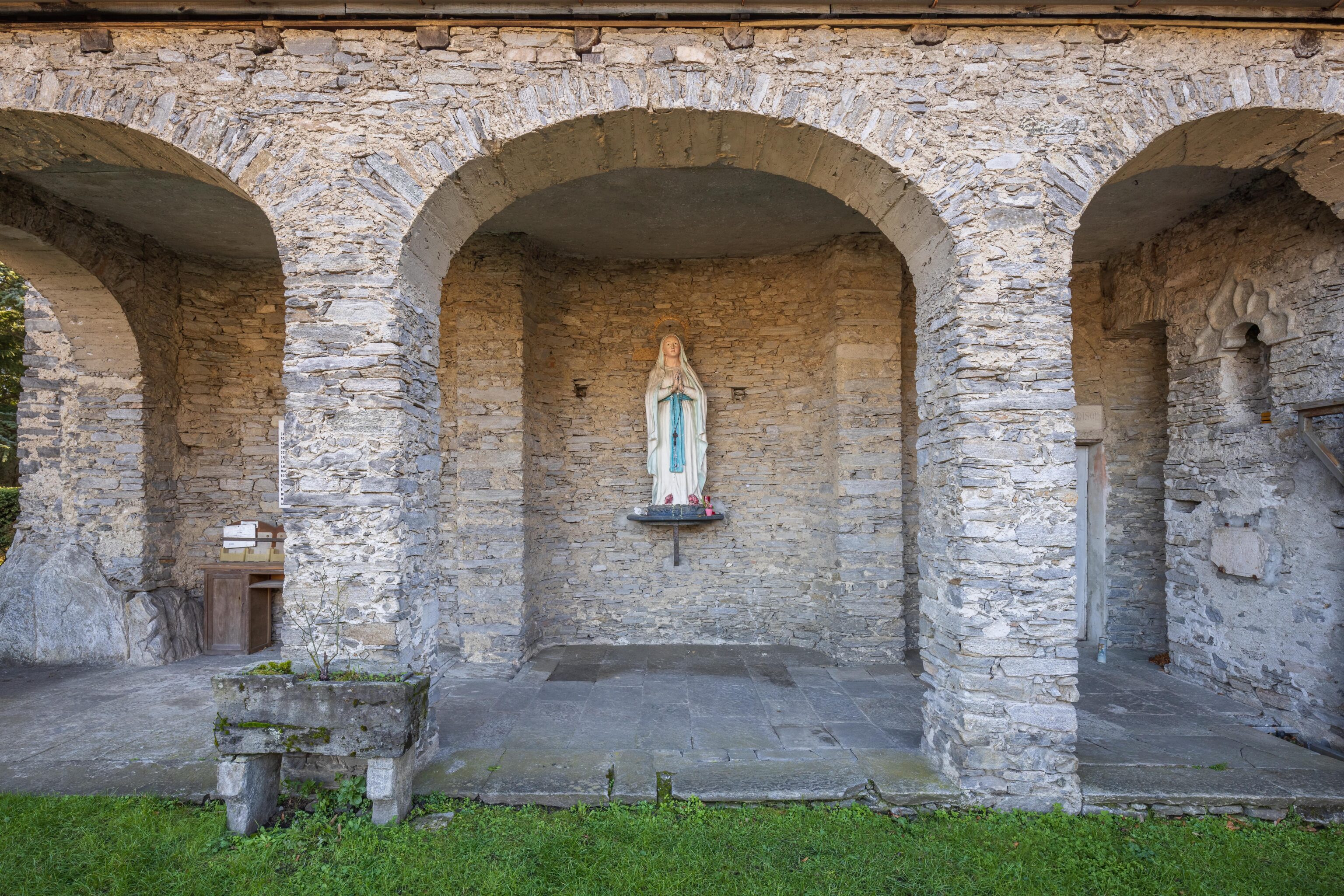
We continued to walk around the site outside.
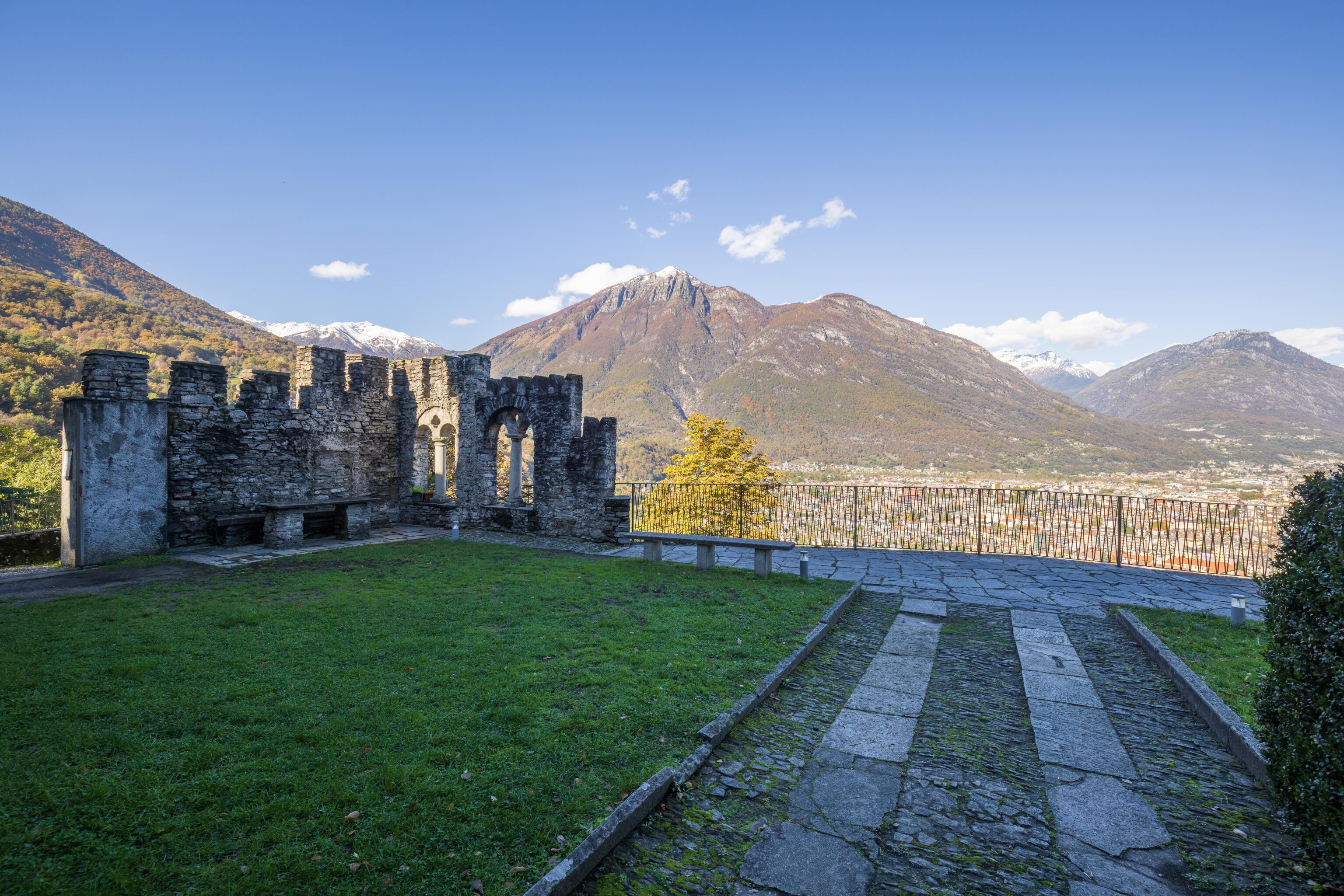
We finally reached the end, overlooking the town of Domodossola! A small section of ruined wall stood at a corner. This part of the site is labelled as the Gardens of Castello di Mattarella on the map.
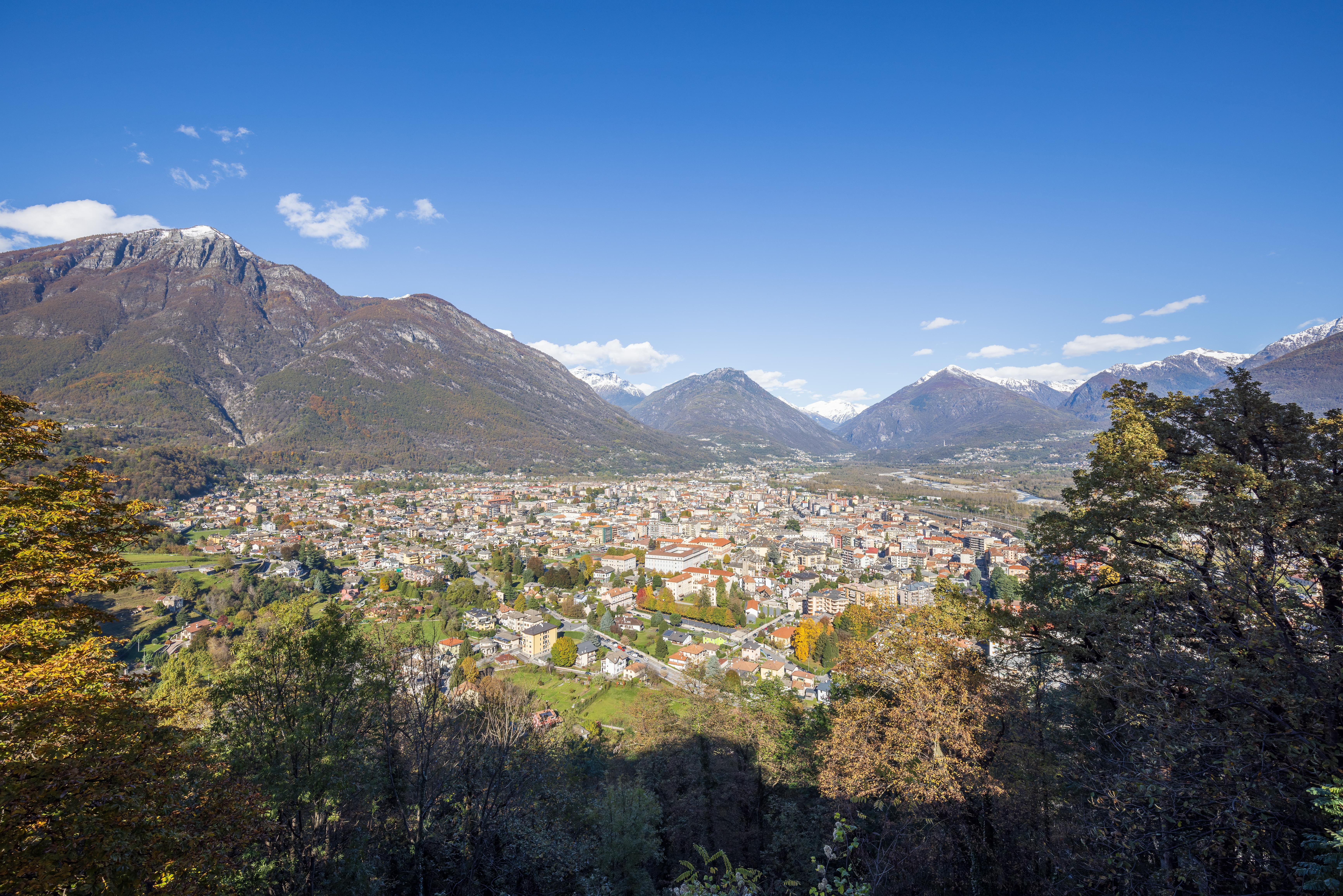
We saw nearly all of Domodossola spread out in front of us.

There were snow capped peaks to the west. Switzerland is just 10 miles away in this direction.

A nice view to the northeast facing the train station.
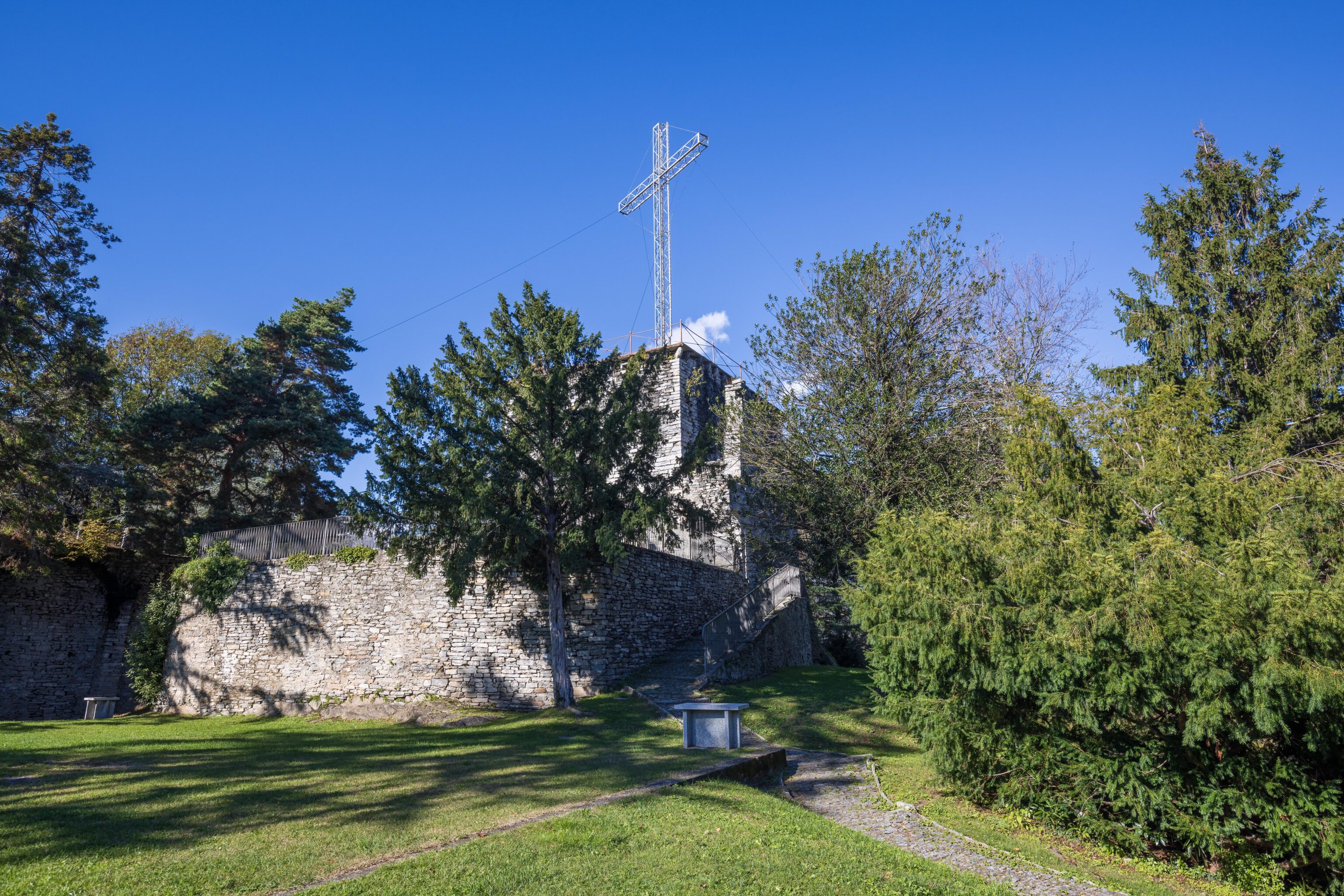
There was a large metal cross standing atop a small building.

The view to the east.
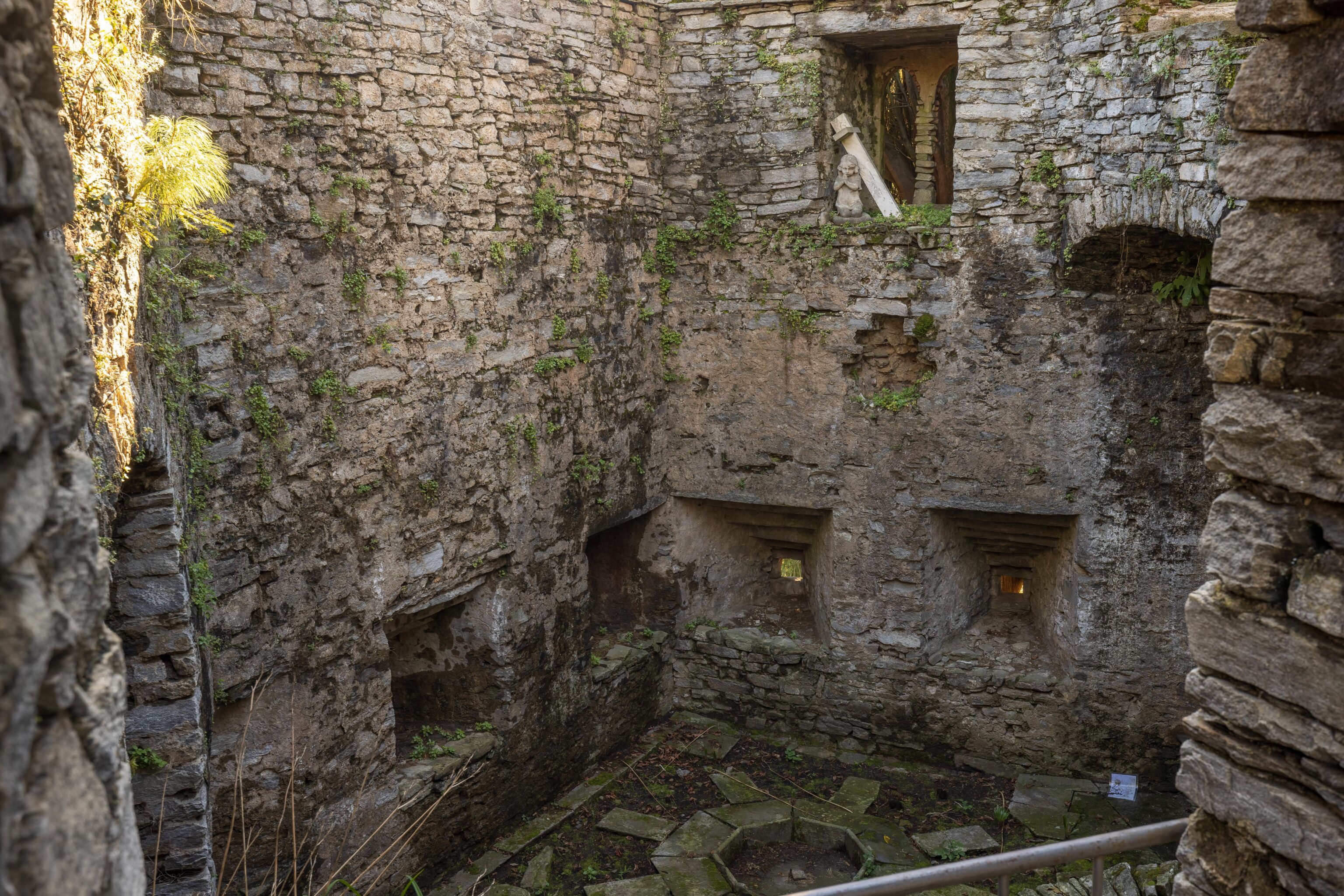

We walked by these ruins of some sort of structure, perhaps a tower?

There was a wall running through this garden area. Most of the other side seemed to be closed off, other than a small passageway leading to the bathrooms.
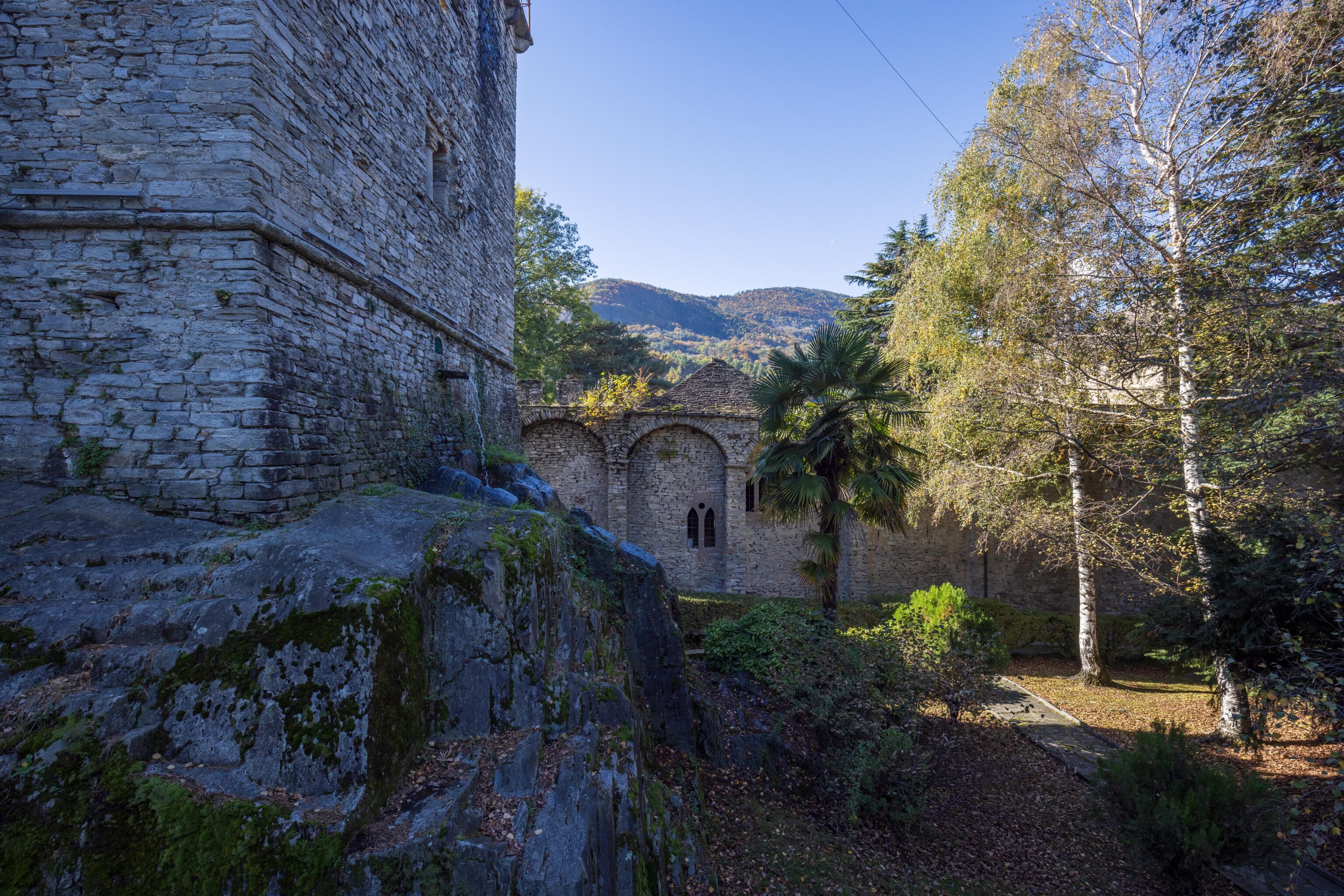
There was an artificial waterfall being fed by water coming out of the building below the metal cross.
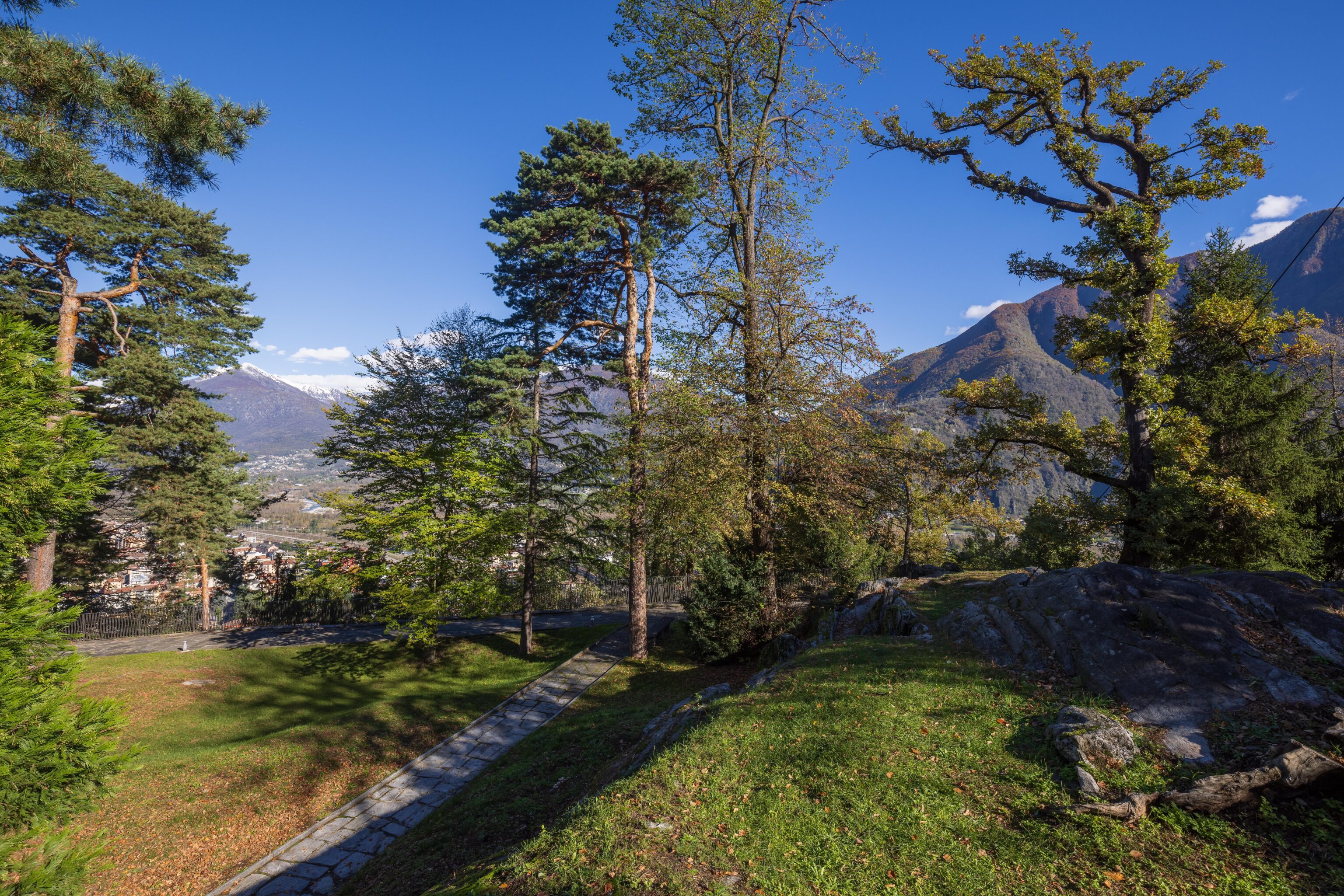
Part of this garden area is occupied by this elevated grassy area with stone forming one of the sides of this little hill.
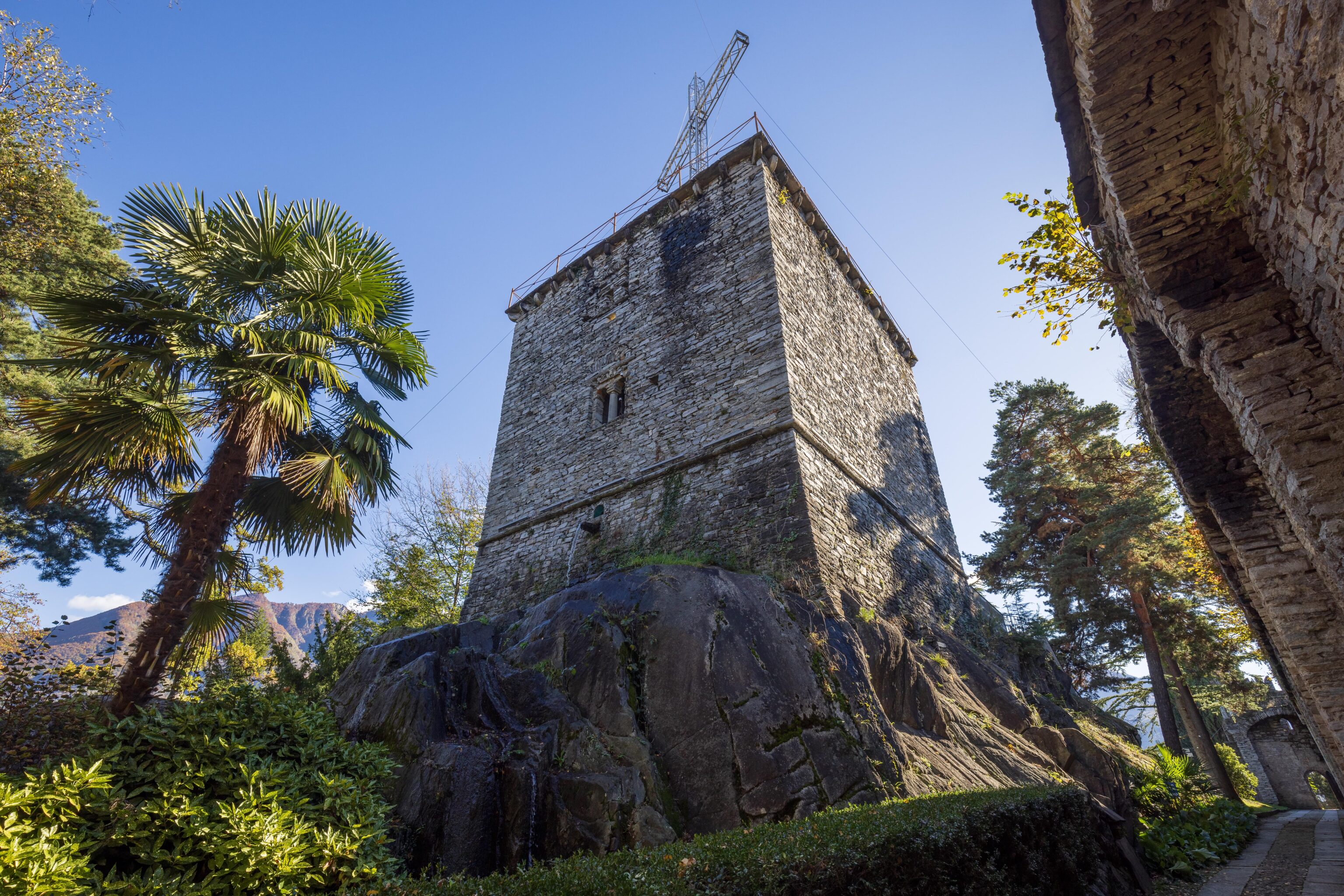
Looking up at the building with the cross and water feature.
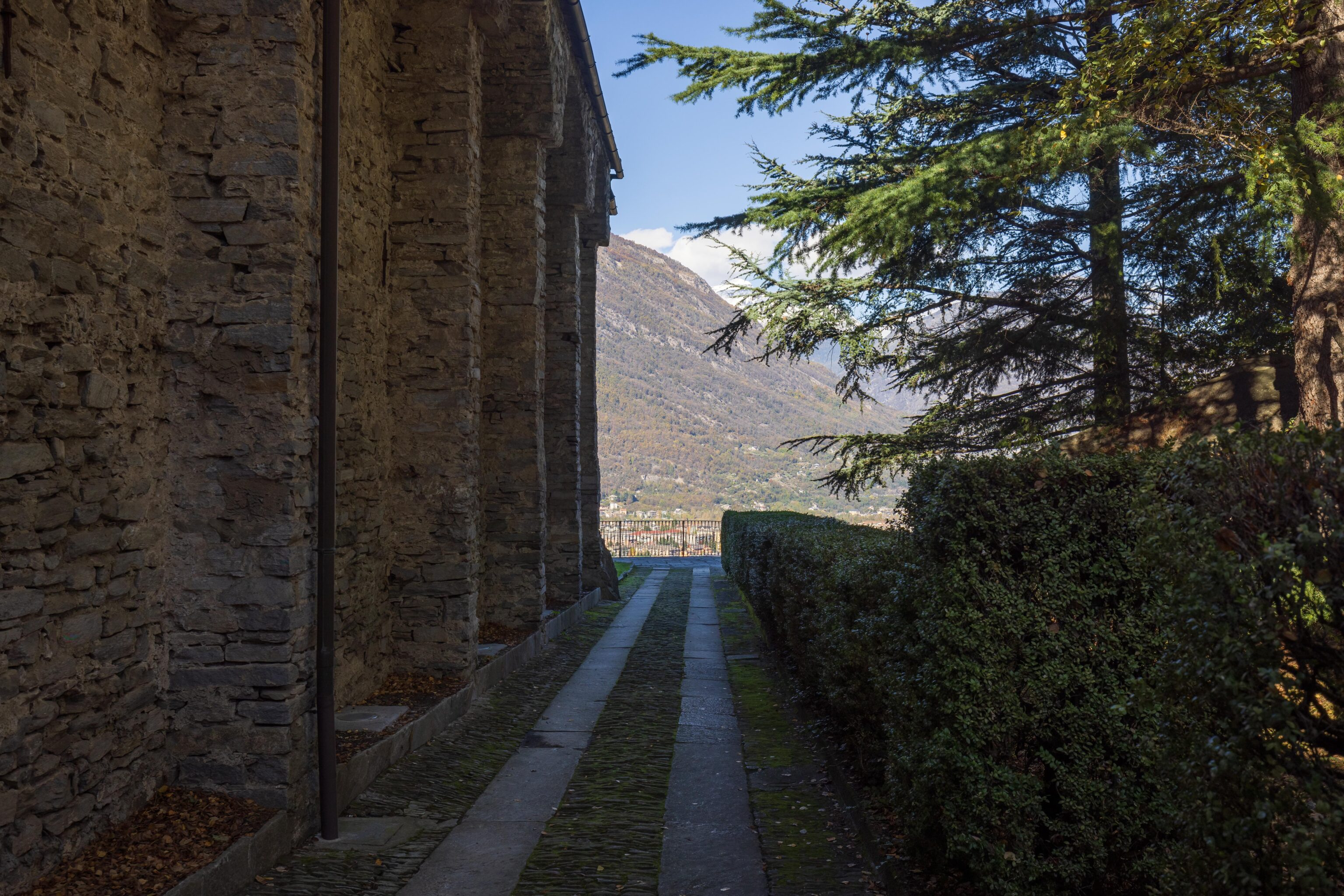
After walking around the garden area, we headed back to the entrance to make our way back.


We walked back the same way that we came, more or less.

Earlier, we had missed stations #1 and #2. We found station #1 at the bottom of the hill at the edge of the town. It wasn’t very obvious when we walked by earlier in the morning that the Via Crucis had already started! As usual, there was a sign:
CHAPEL I Jesus standing before Pilate The chapel with a classic circular design surrounded by a peristyle completed by granite columns only on the part facing the street, dates back to the 1900. It has replaced a previous chapel designed by architects Perini and painted by Carlo Canepa in the mid-seventies. It was later used for storage of mine powder and destroyed by an explosion in 1830. The 21 statues are the work of the sculptor and modeller Pietro Mosca from Biella.
We learned earlier this year after visiting Mount Pilatus that it was named after Pontius Pilate, the Roman governor of Judaea who ordered Jesus’ crucifixion. The exact reason why the mountain carries his name seems to be unknown and there are various legends that try to explain the name.

We found station #2 by backtracking a bit, maybe a few dozen feet! It was unfortunately being renovated. Unlike station #9, where we could at least see in a bit, we couldn’t see anything inside at all. There was an informational sign, like at all the other stations, but we didn’t photograph it.

There was some art above the entrance but that is all we could see. We did find a nearby sign that had quite a bit of text on the Via Crucis:
SACRO MONTE OF DOMODOSSOLA: A DEVOTIONAL JOURNEY DEDICATED TO THE WAY OF THE CROSS The religious purpose for which the, Sacri Monti were conceived was to imitate Jerusalem as a pilgrimage destination. With the Council of Trent, they were later used by the Counter-Reformation to resist the advance of Protestantism. The Sacro Monte Calvario of Domodossola was specifically conceived as a symbol of devotion to the Crucified Christ, and the fifteen chapels built starting from 1656 were created as a magnificent Way of the Cross. The work design and management were originally assigned to master Tommaso Lazzaro della Val d'Intelvi, and after 1690, they were passed on to other Initelvian architects, the masters Antonio and Domenico Perini and later to architect Pier Maria Perini. A considerable part of the Sacro Monte is represented by the plaster statue work assigned to the Milanese Dionisio Bussola, "protostatuary" of the Duomo of Milan, who was a well known artist trained in Rome at Bernini's school, and to his helper Giovanni Battista de Magistris, known as Volpino; the artist Giuseppe Rusnati of Gallarate took Bussola's place at the beginning of the 18" century. The pictorial decoration, including the frescoes and the colouring of the statue, was entrusted to Carlo Mellerio, Giovanni di Sampietro of Milano, Tarquinio Grassi of Romagnano, Carlo Canepa, Secondo Sestini, Giuseppe and Antonio Toriicella of Cusano and the Valsesian Lorenzo Peracino. Originally, wooden crosses were placed to mark the locations chosen to build the chapels and a map was drawn with the exact position of each station. The construction of the Church of the Holy Cross was begun in 1657, followed by the chapels IV, IX, II, the Oratory of the Madonna delle Grazie and the Santa Casa di Loreto. The chapels X, XV and I were built at the beginning of the 18" century. In 1764 a new stage began with the construction of chapels XI, VII, VI and VIII. In 1835, the Rosminian Fathers built chapel V. In 1900 chapel was rebuilt after it was destroyed by an explosion in 1830, and finally in 1907 came the construction of the III chapel. In the Sacro Monte Calvario, each chapel is connected by a Via Sacra or Via Regia or Trionfale, best known as Via Regia Crucis. The clergy and the people would walk the Via Sacra in solemn procession praying and meditating, stopping at each mystery of the Passion depicted. The Via Crucis began with a Triumphal Arch, called by the Ossolani the Arch of Pilate, which stood out among all other common roads. Built in 1658, it remained untouched till 1875 when the Municipality knocked it down for "better building aesthetics". Decorated with a variety of paintings and sculptures, it carried inscriptions exhorting us to worship God the Redeemer and to look upon the Cross.
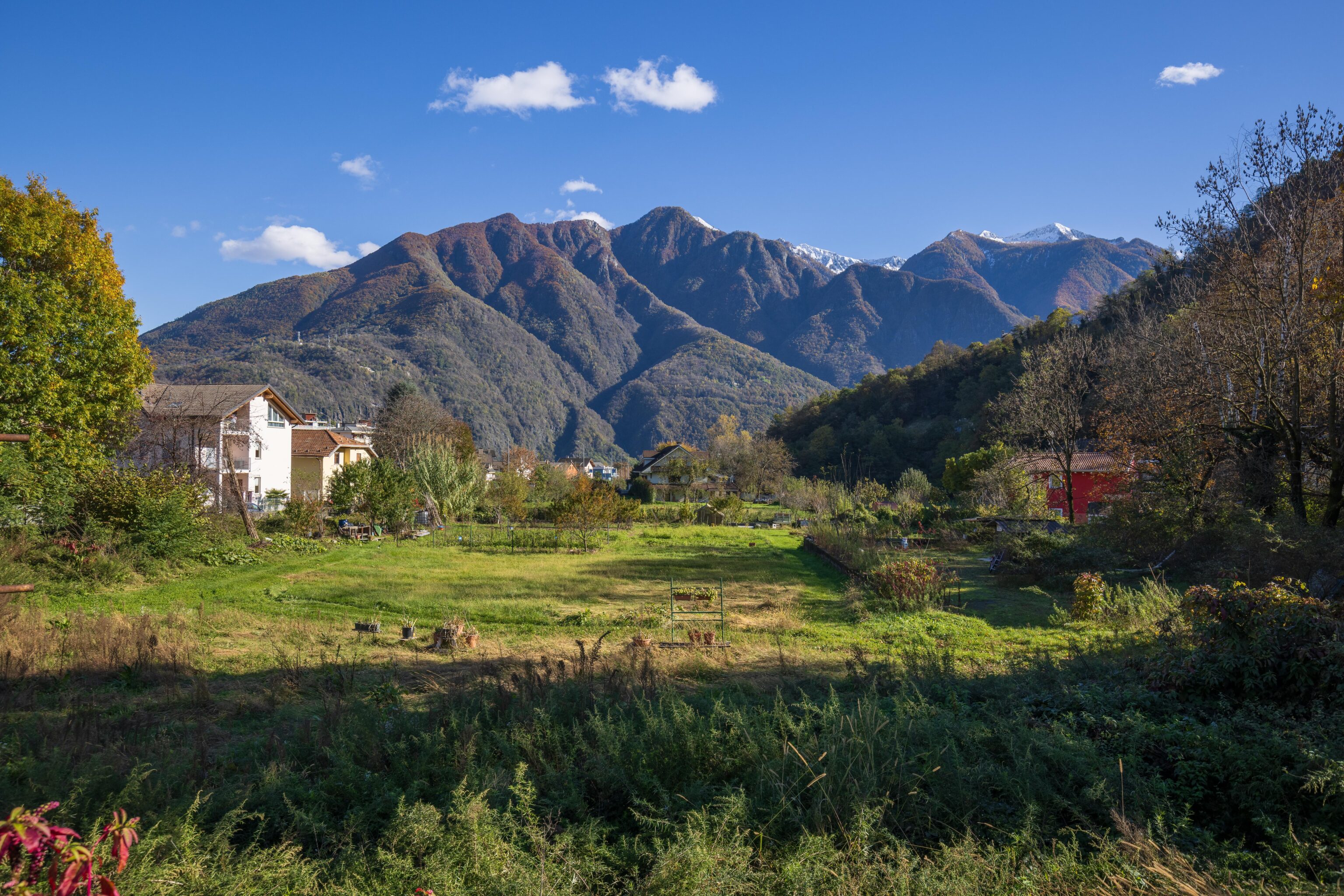
After station #2, we headed back into town to find a place for a late lunch. It was 1:15pm and we knew it may be difficult to find a place to eat after 1:30pm or so.

We walked along the same road as we did earlier in the day.

A typical building. Its chimneys kind of look like little houses.

A typical street scene in Domodossola. There weren’t very many people around. We decided to eat at Terminus, a restaurant with a variety of Italian dishes on the menu. We knew this would be our only meal in Italy on this trip so we wanted to try as much as we could!

The first item to arrive was the Pizza Diavolo. We found it interesting that it didn’t come sliced. Instead, we cut it with a knife. It tasted quite good! It also came with an optional spicy oil based sauce that could be used to give it a bit of heat.
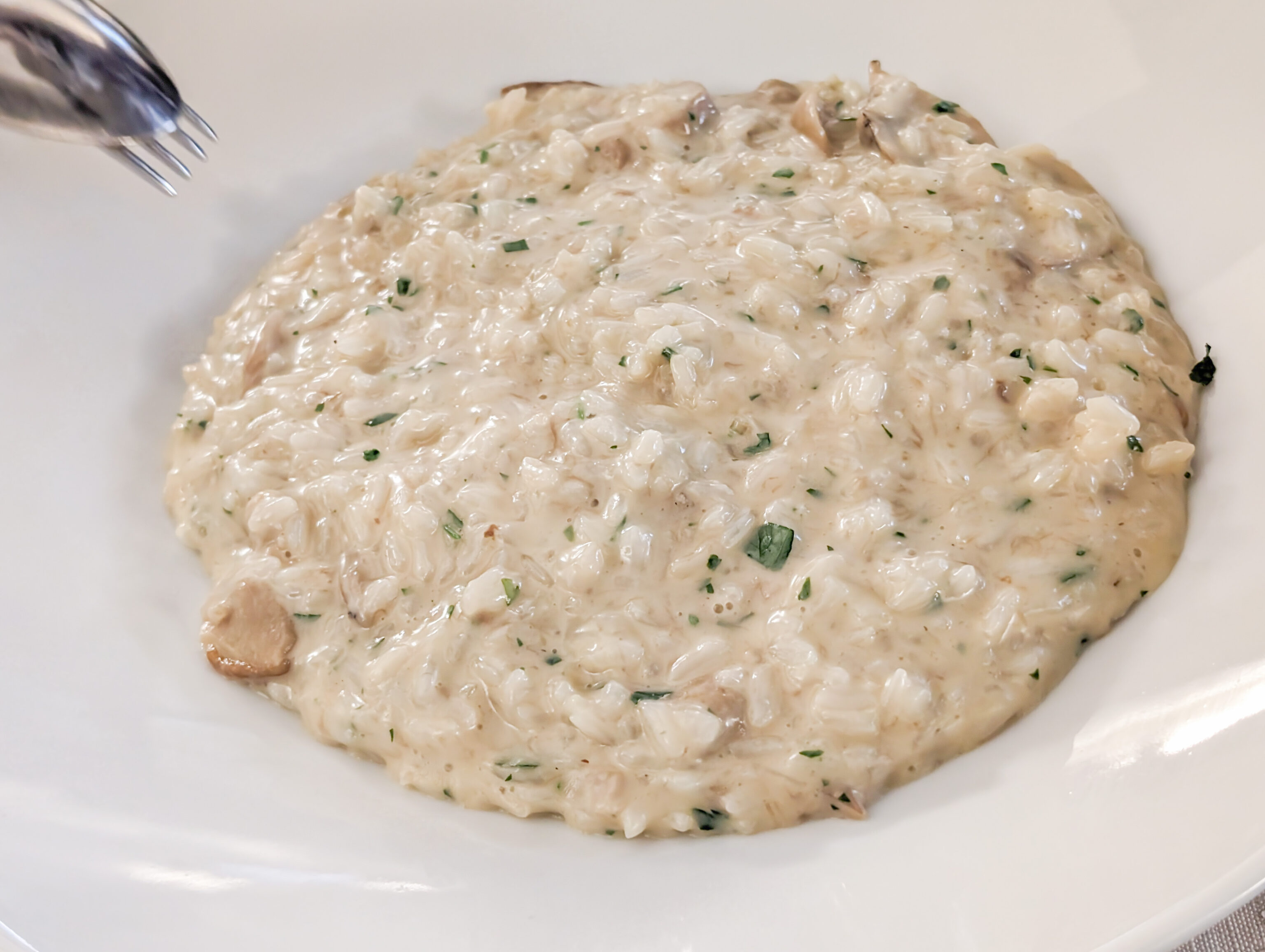
The next to arrive was the Mushroom Risotto. It was good as well with excellent flavor.

Our third dish was the Seafood Spaghetti. Although it was good, we probably should have got some tomato based pasta dish instead as a first time in Italy thing.

For dessert, we had a Tiramisu. It was good as well.

We also had a bit of local red wine.

The interior design was simple with some rustic touches. It was pretty busy when we arrived, though it mostly emptied out by the time we left as we started pretty late at around 1:30pm. Overall, the food was great and it was significantly cheaper than Switzerland!

After eating, we decided to walk around town a bit. We passed by these empty tables. Perhaps they would have been full an hour or two ago?

The Piazza del Mercato was quiet, just like in the morning.


We walked by a very old looking church building.


We walked around to find the front of the church. It looks very different!
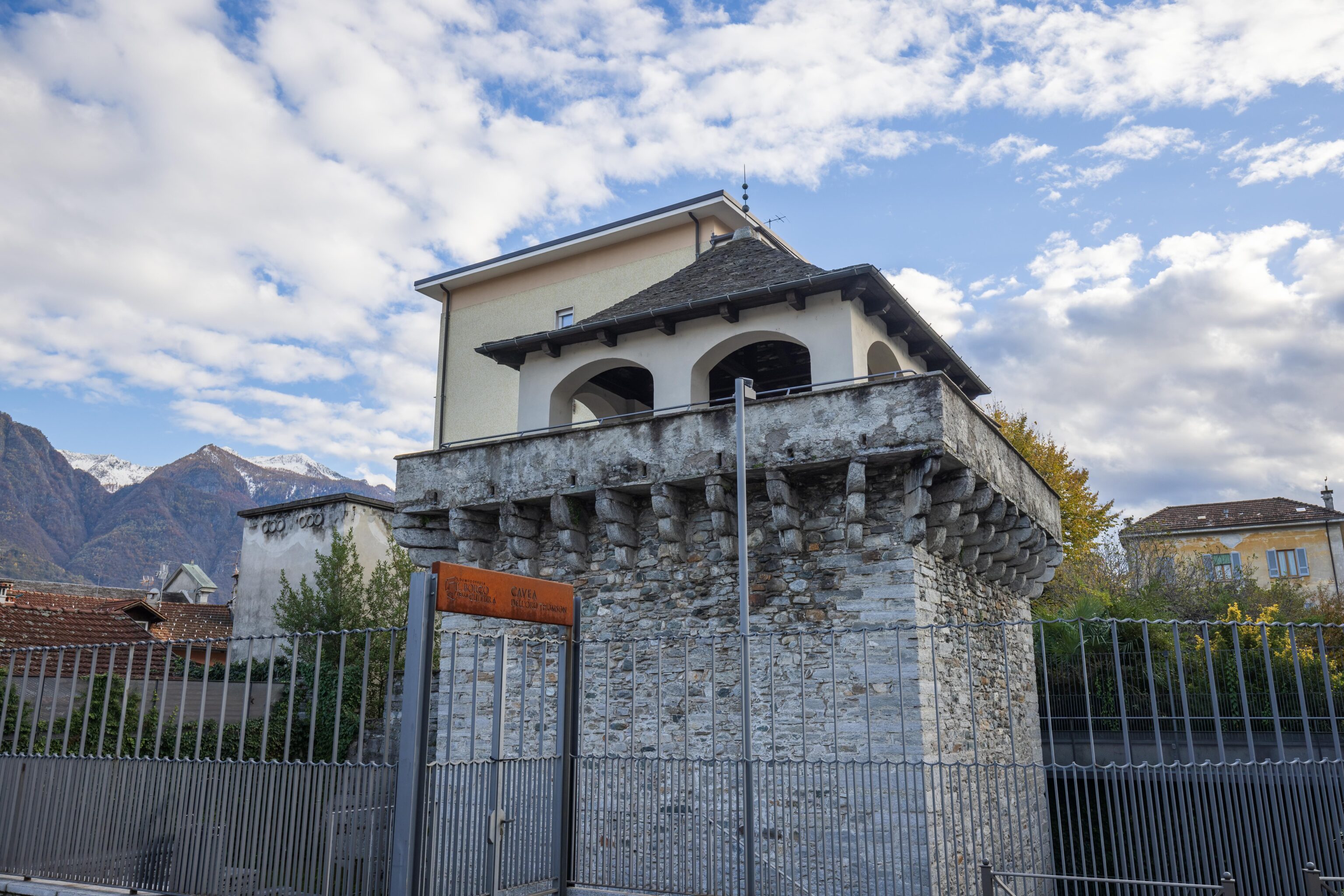

About 700 years ago, a defensive wall was built around Domodossola. This tower is part of what remains from then. It looks like it is possible to go in to get a closer look, however, it was closed today.
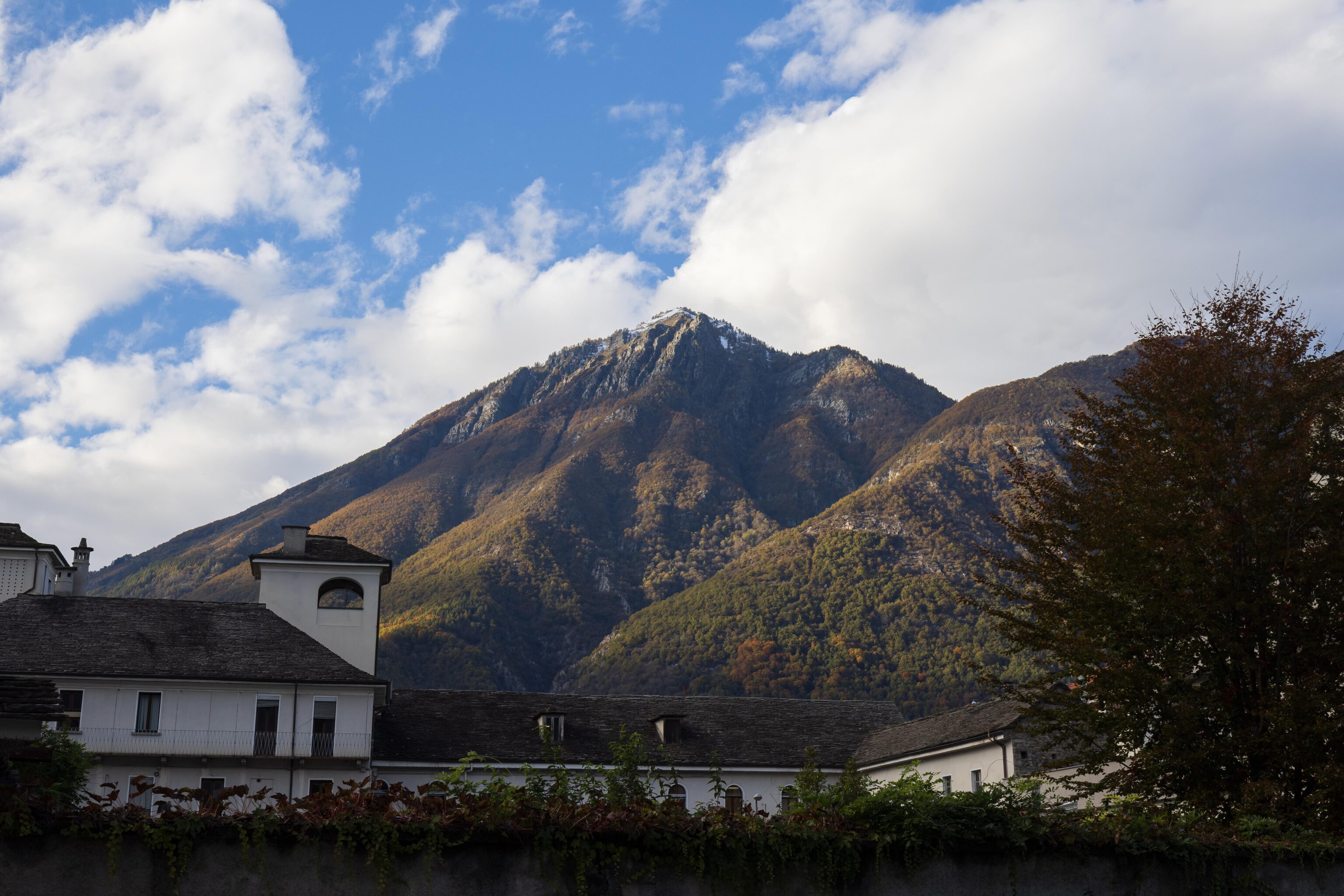
We continued to walk around the town, passing by this nice view of a mountain.
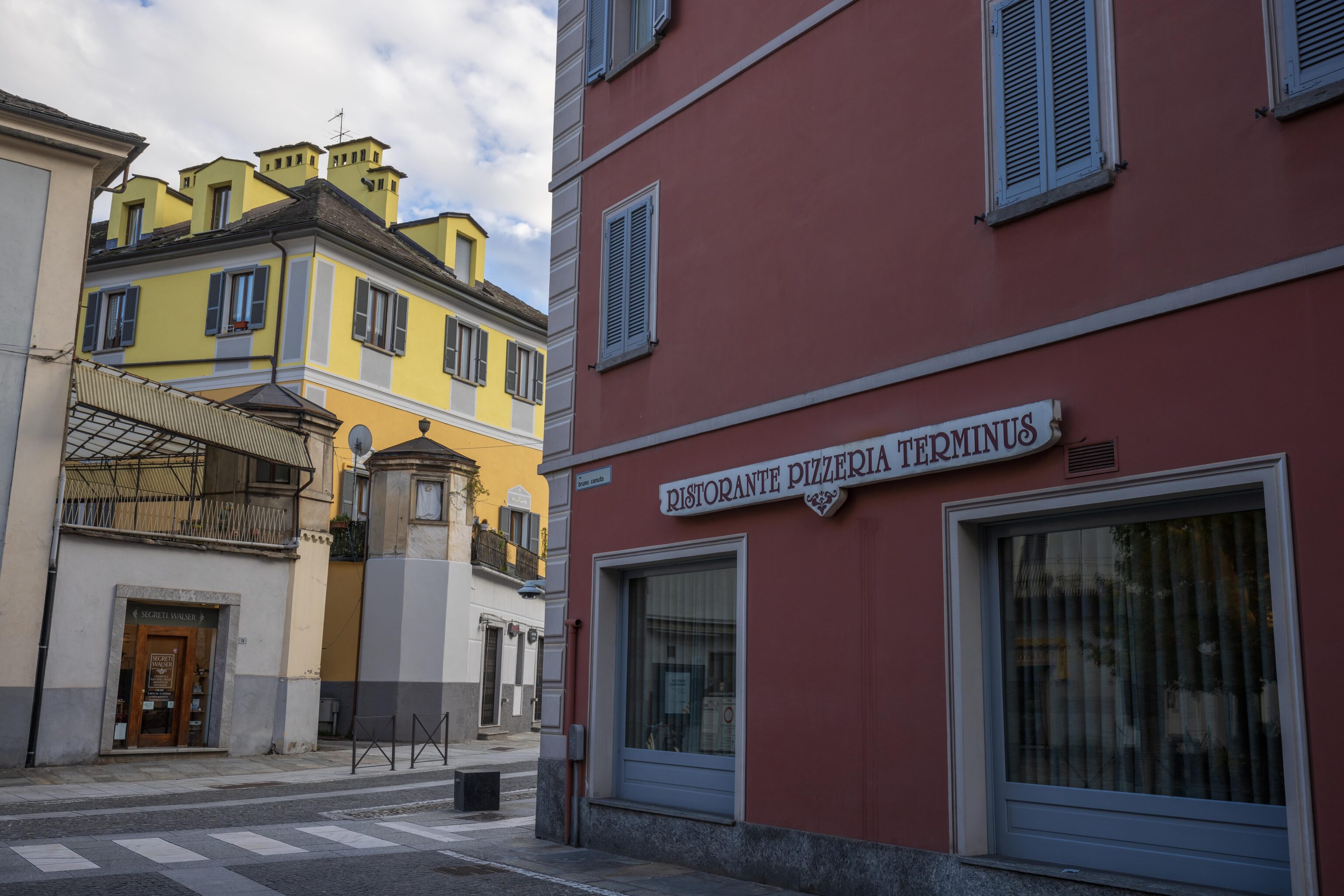
We ended up back by Terminus, where we had lunch! From here, we decided to head back to the train station to return to Switzerland.
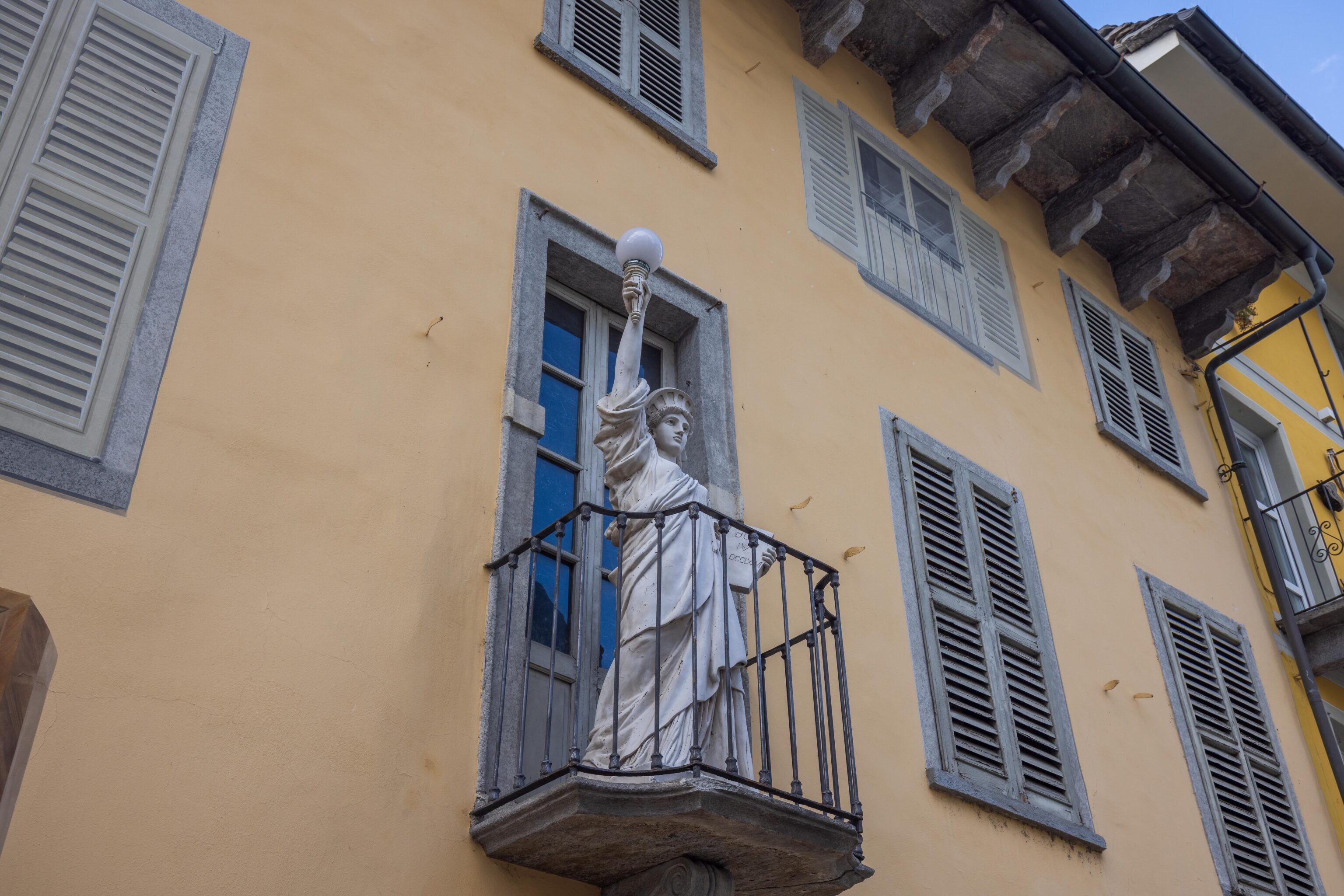
We passed by this little Statue of Liberty on a balcony! She seems relatively realistic, other than her torch being a big light bulb!
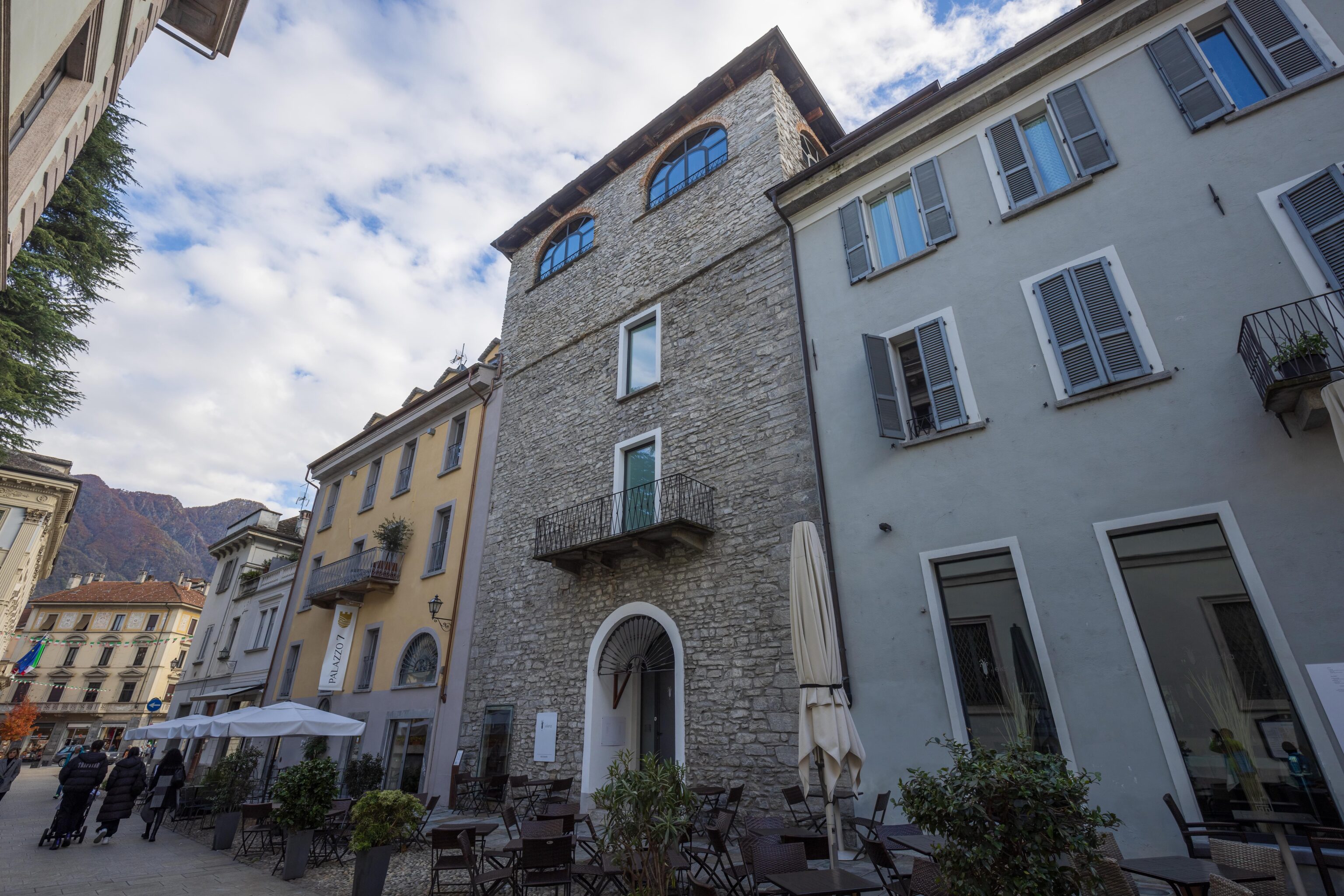
According to a sign, we think this building was previously part of a castle but has been converted for modern uses.

A sun clock on a wall. These things seem universally common in Europe!

This seems to be city hall?
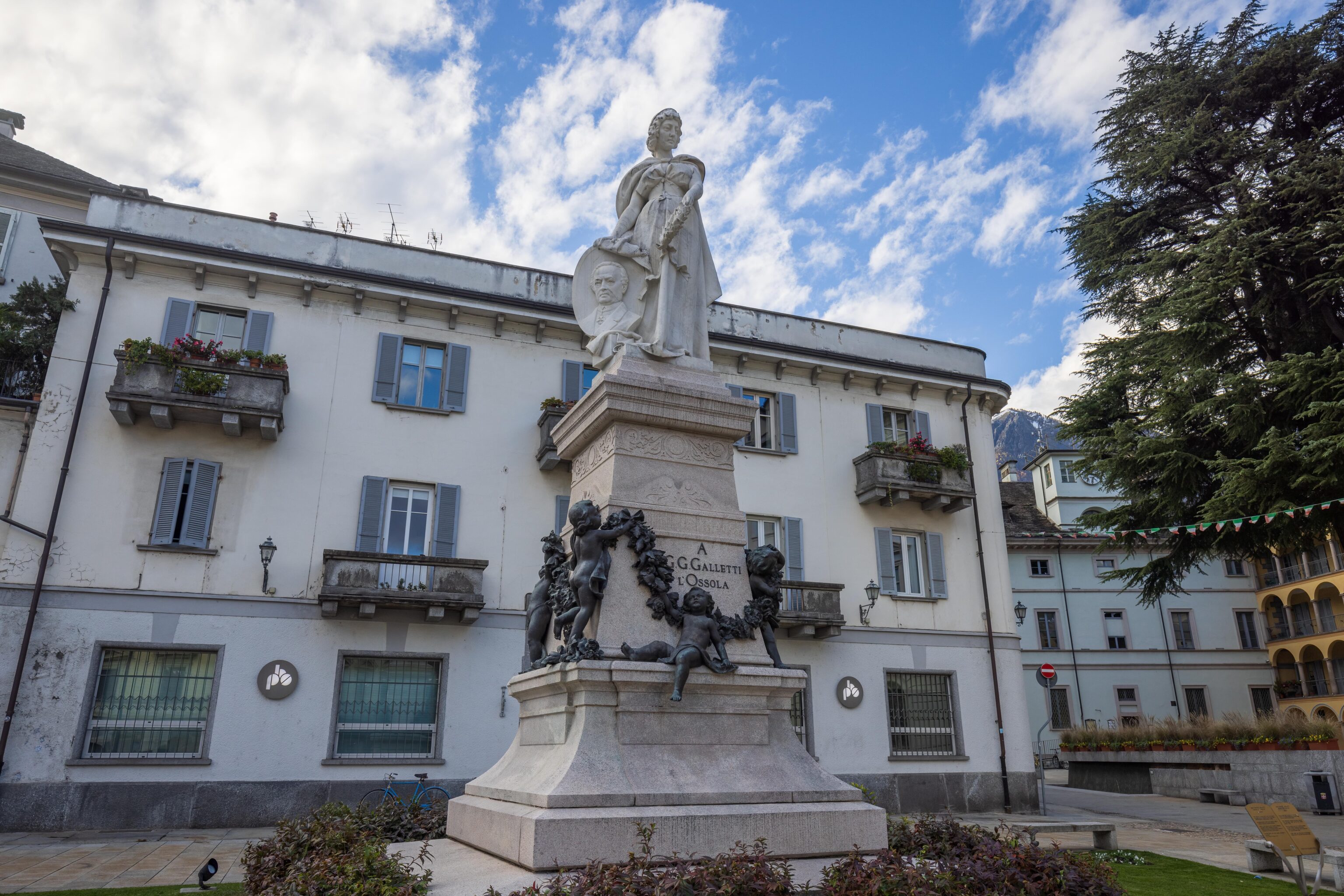
This seems to be a monument to Gian Giacomo Galletti. It seems he donated money for schools and hospitals in Domodossola and ultimately became a local politician.
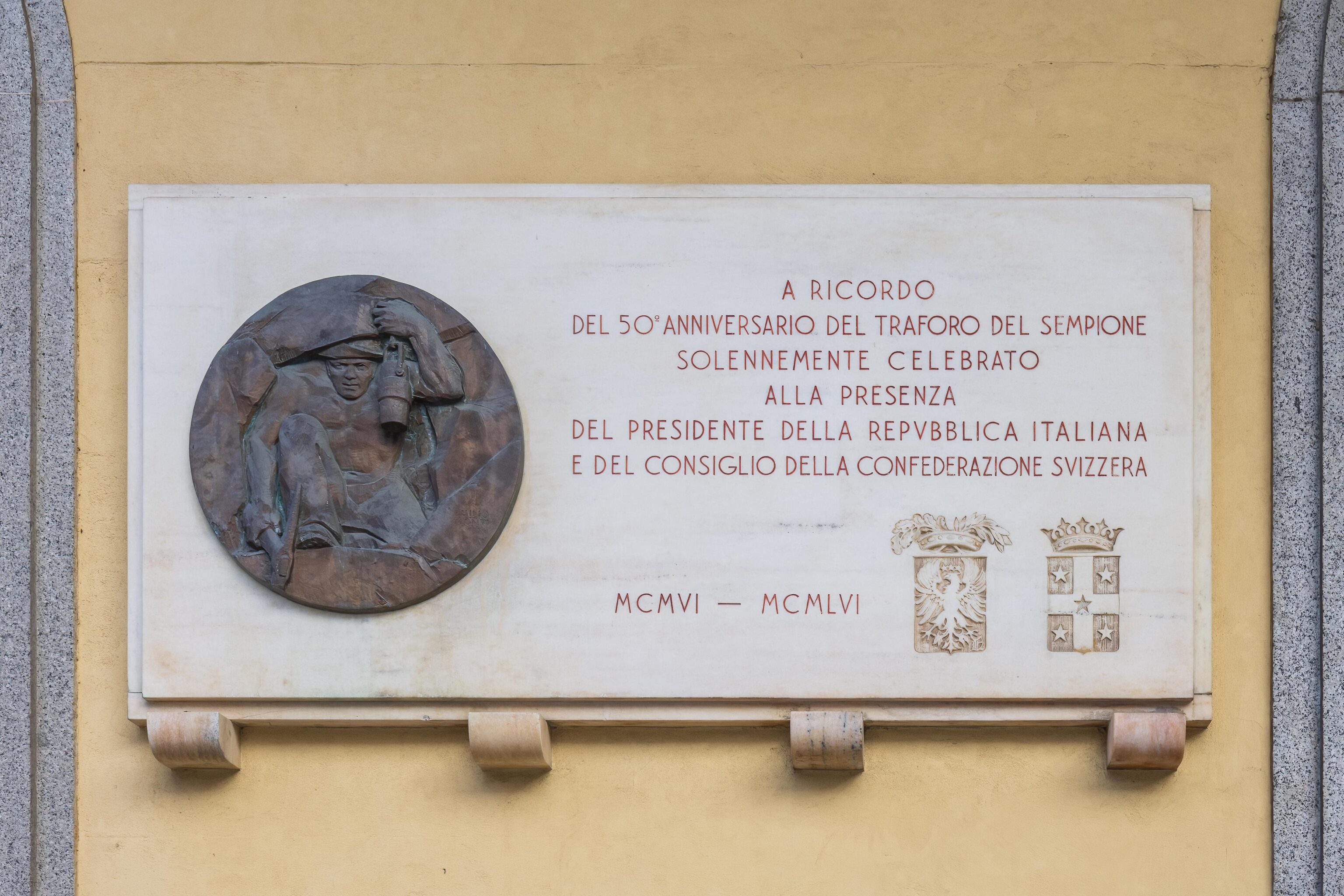
This plaque is dedicated to the 50th anniversary of the Simplon Tunnel, built in 1906 to connect Switzerland and Italy and avoiding the need to traverse the mountain pass above. This is the tunnel that our train took between Brig in Switzerland and Domodossola.

We decided to take a Swiss train back. This required taking a local train to Brig before switching to an InterRegio train to Montreux.

We had a bit of time in Brig before catching the IR to Montreux. Enough to get some roasted chestnuts from a stand outside the station. The same vendor was here a year ago when we stopped here on our way to Fiesch to the east! We also briefly look a look at the surrounding scenery.

We noticed this rail sculpture by the train station. The middle tracks interlock like zippers! This sculpture seems to be titled Verbindungen (Connections) and was made using rails from the Simplon Tunnel for its 100th anniversary3. There isn’t much information about this sculpture, at least not easily discoverable in English.
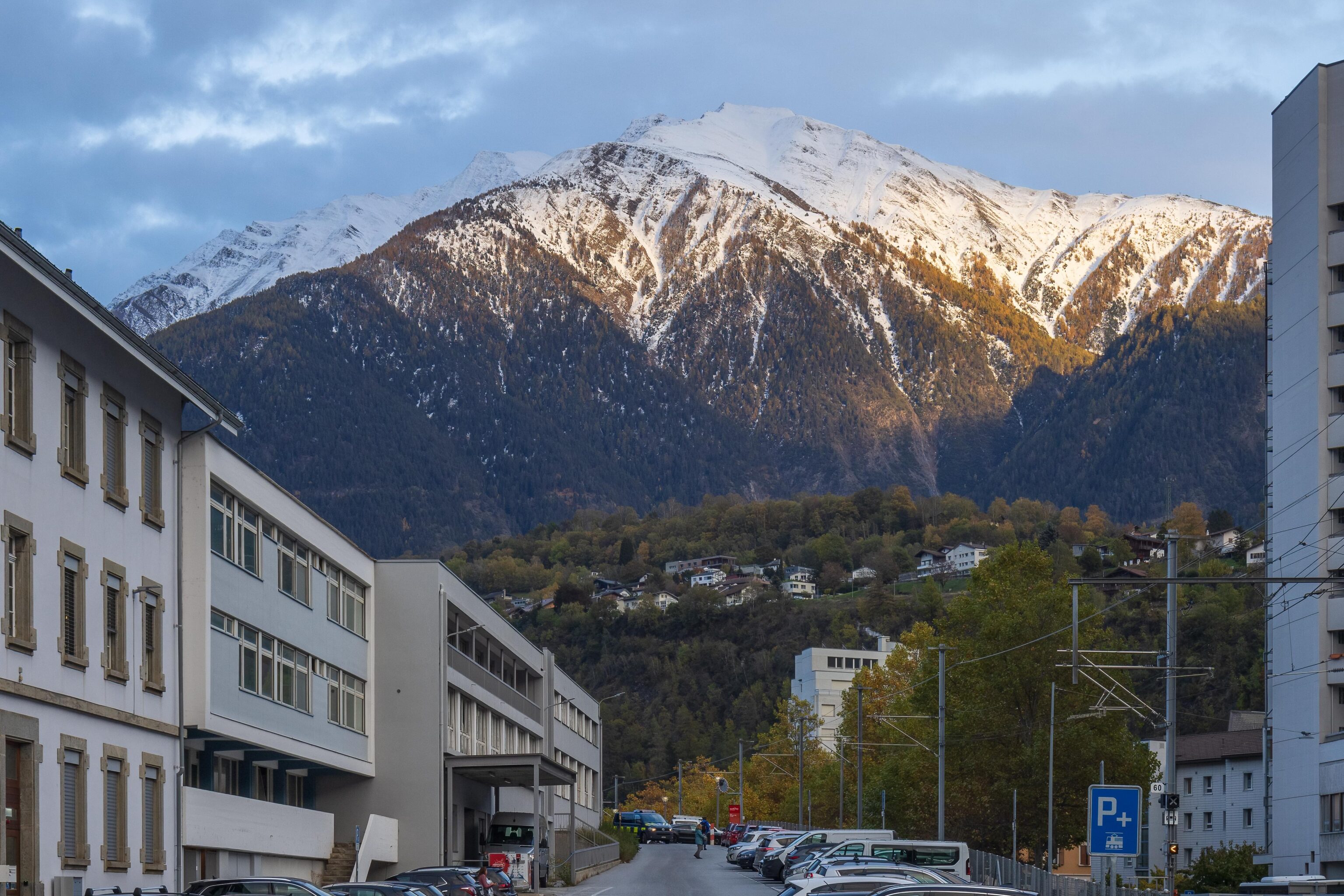
Brig is located in a long valley that runs through much of the Swiss Alps. There are basically mountains in all directions!

Time to head back into the station to catch our train!

